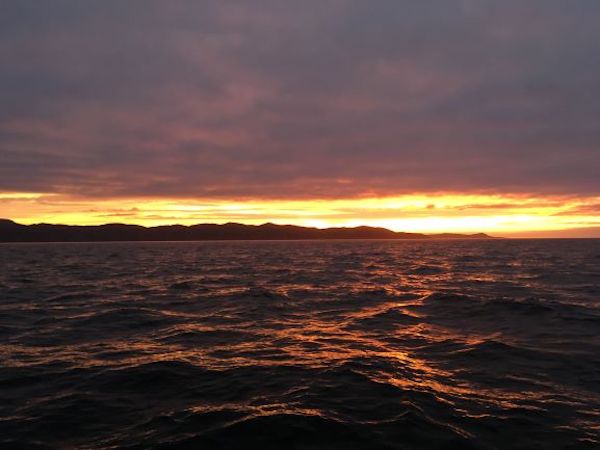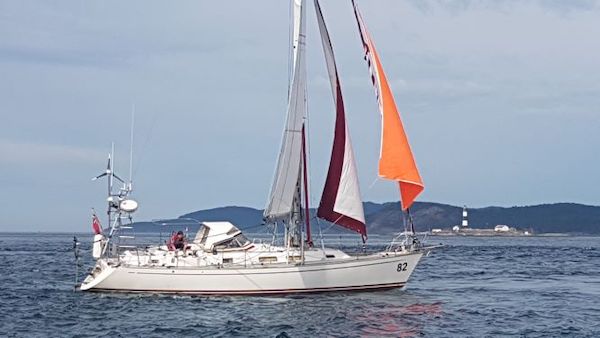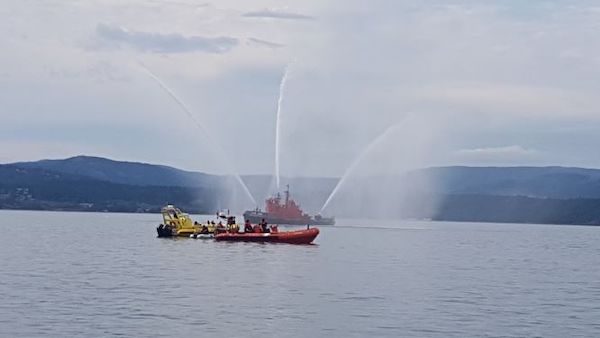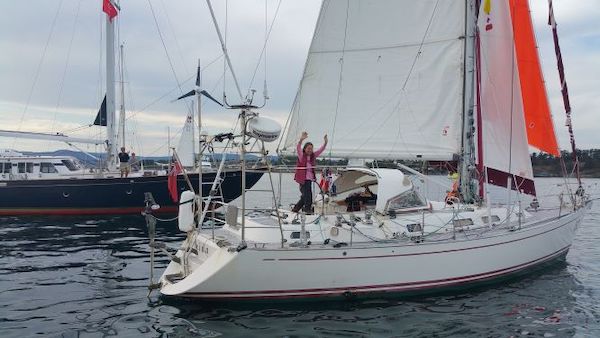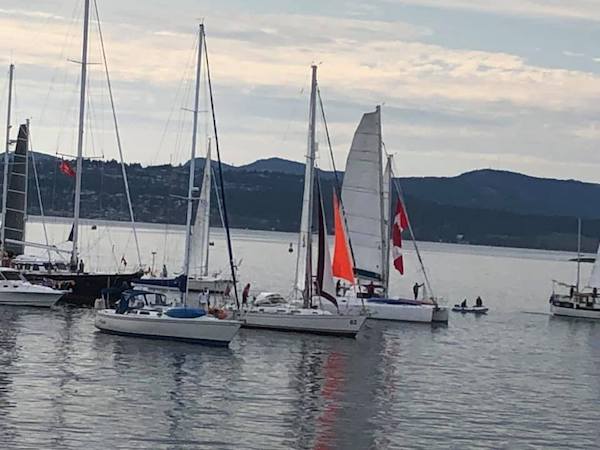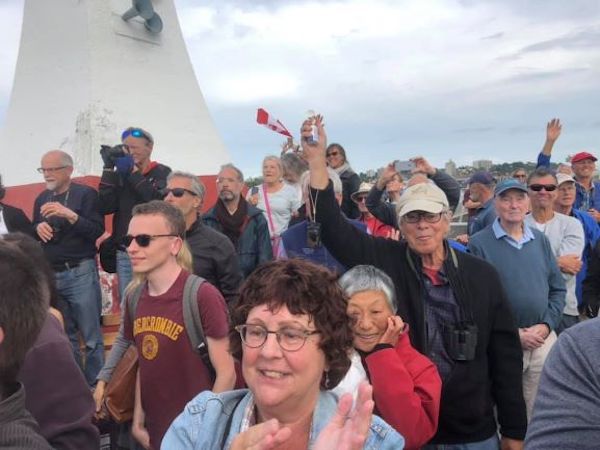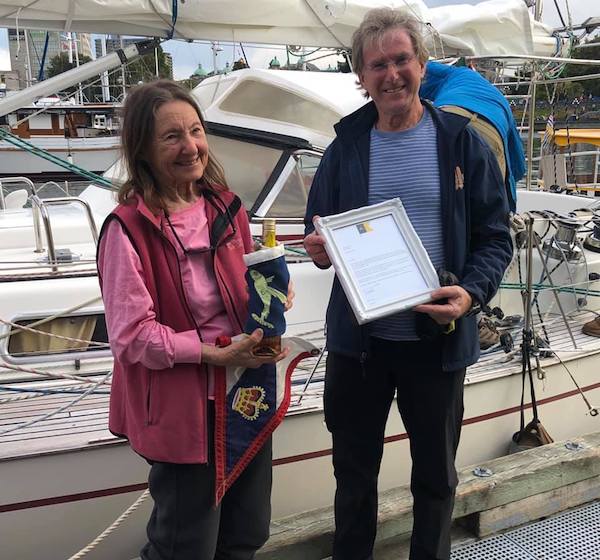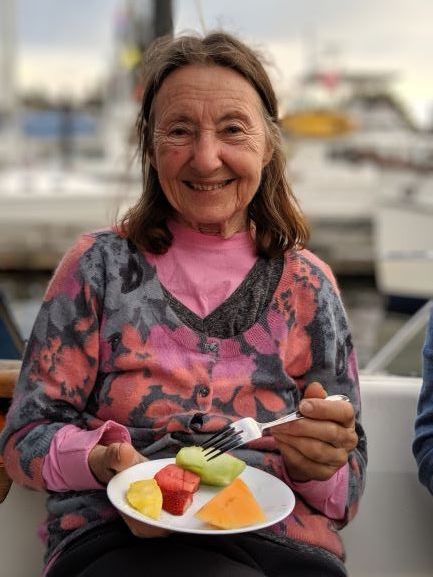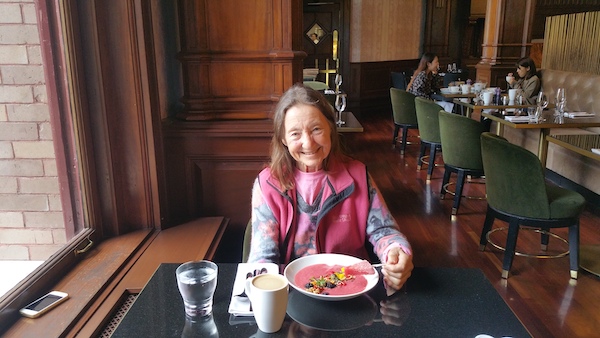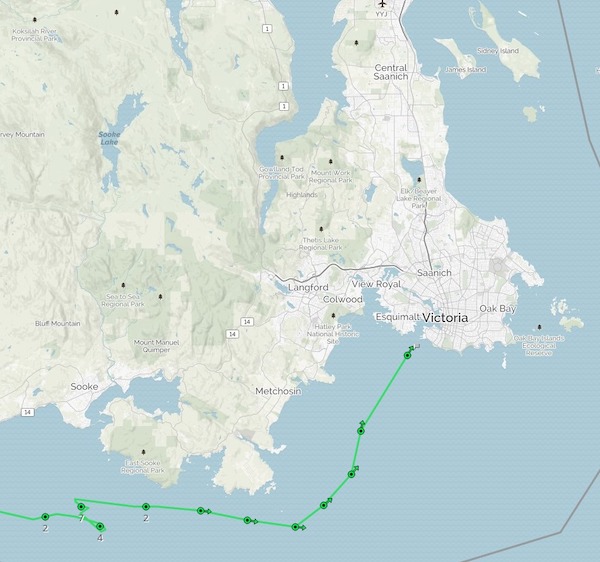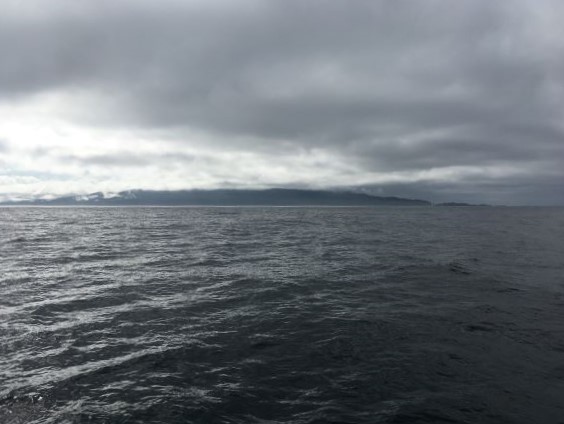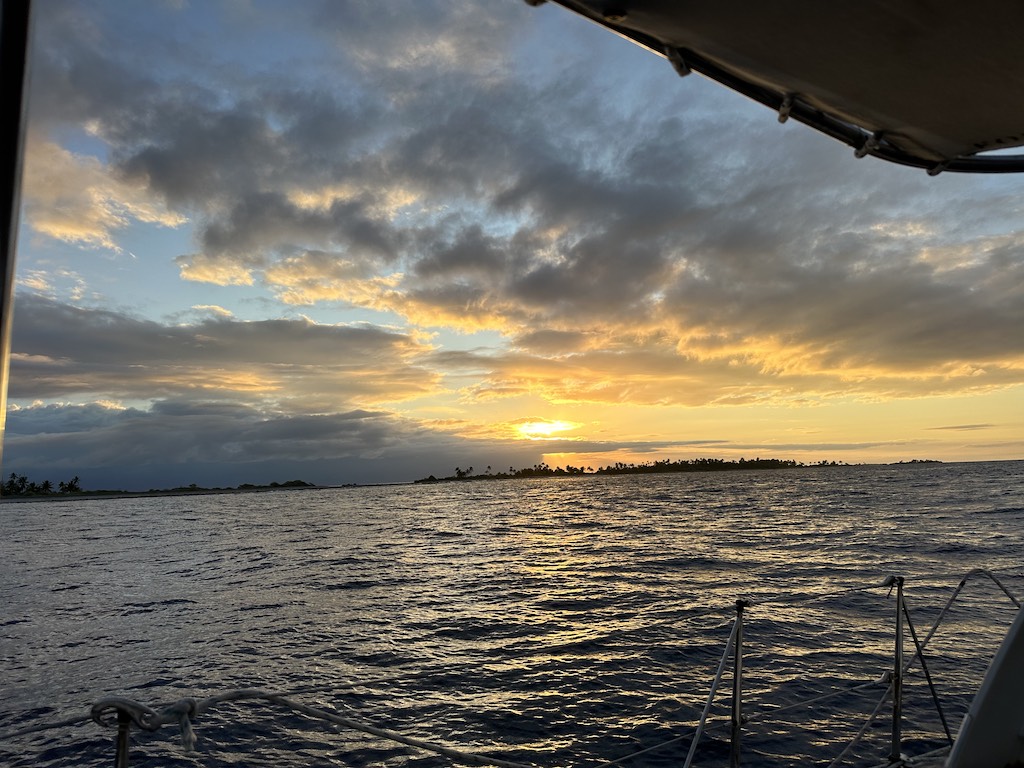
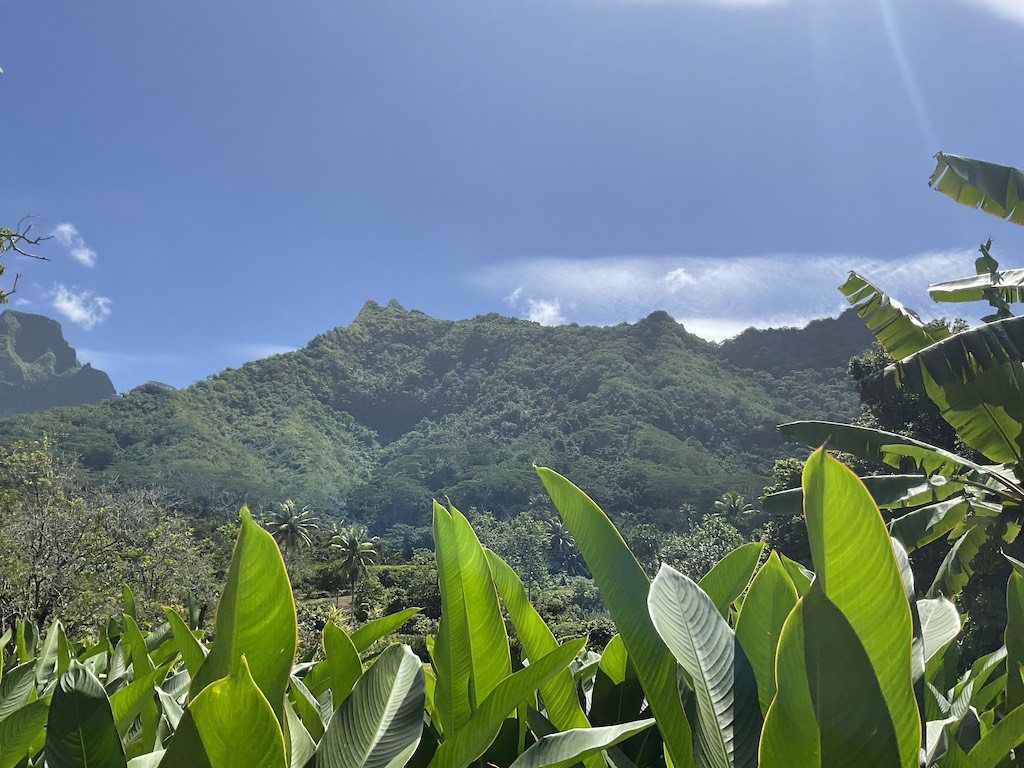
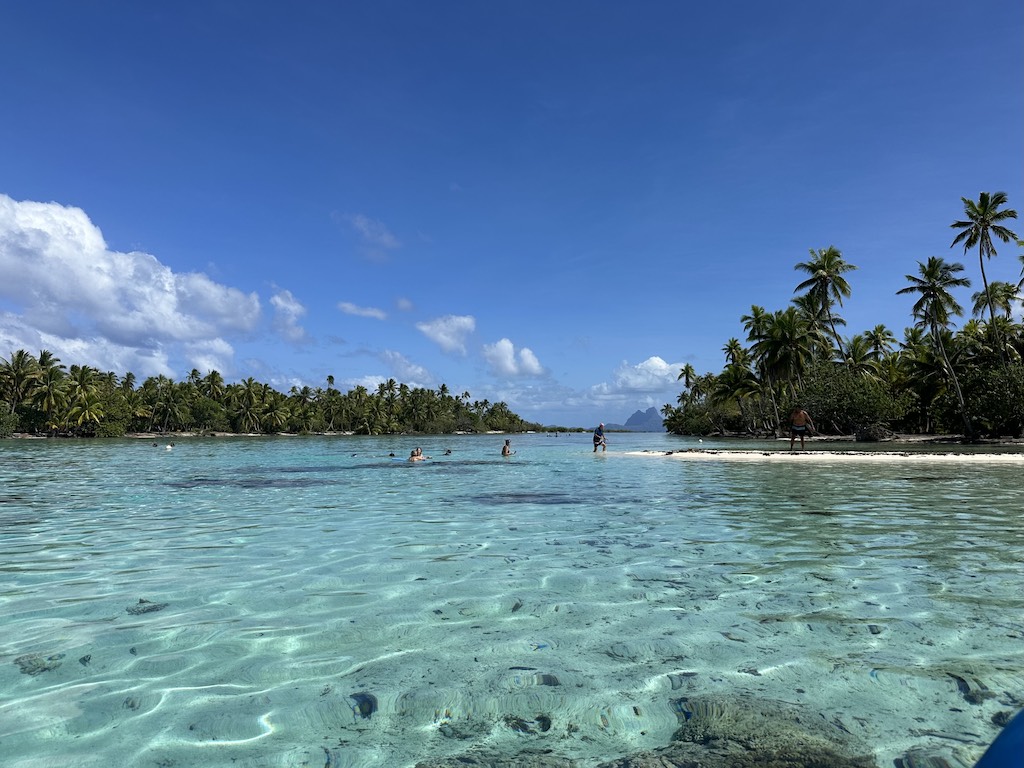

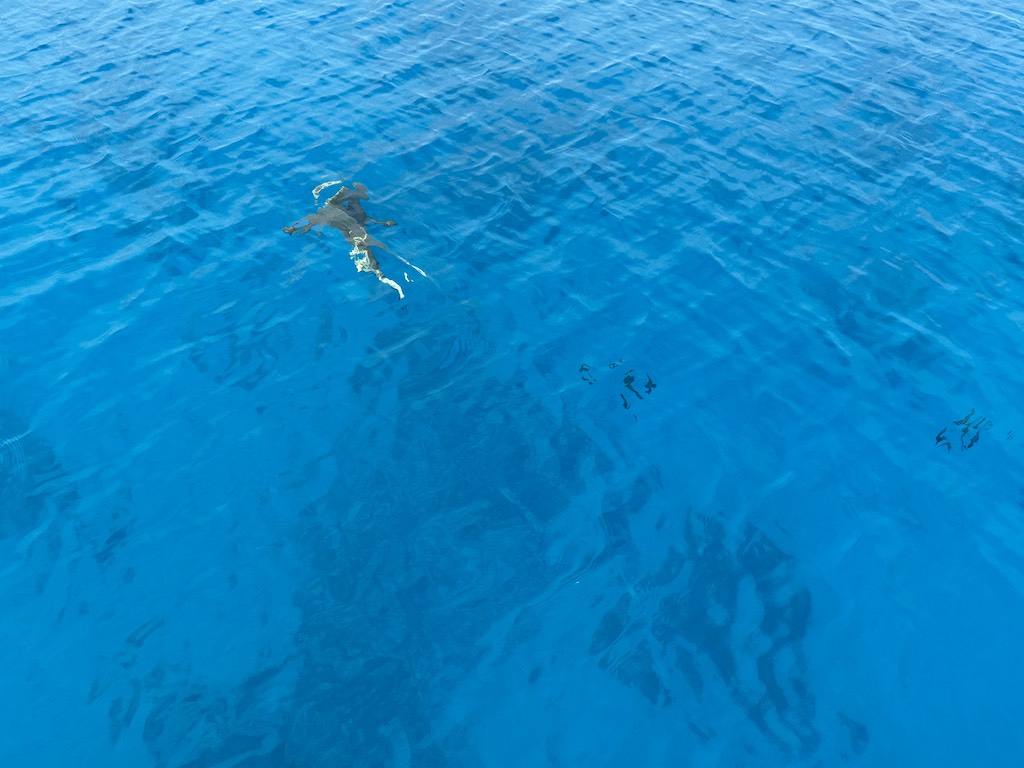
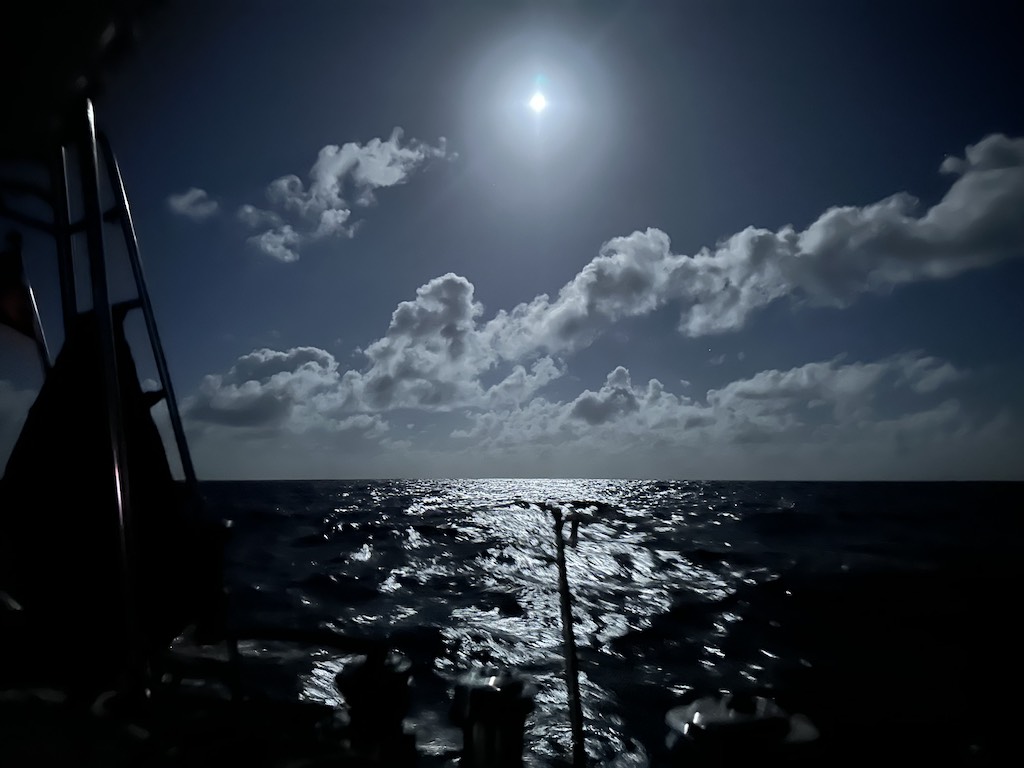
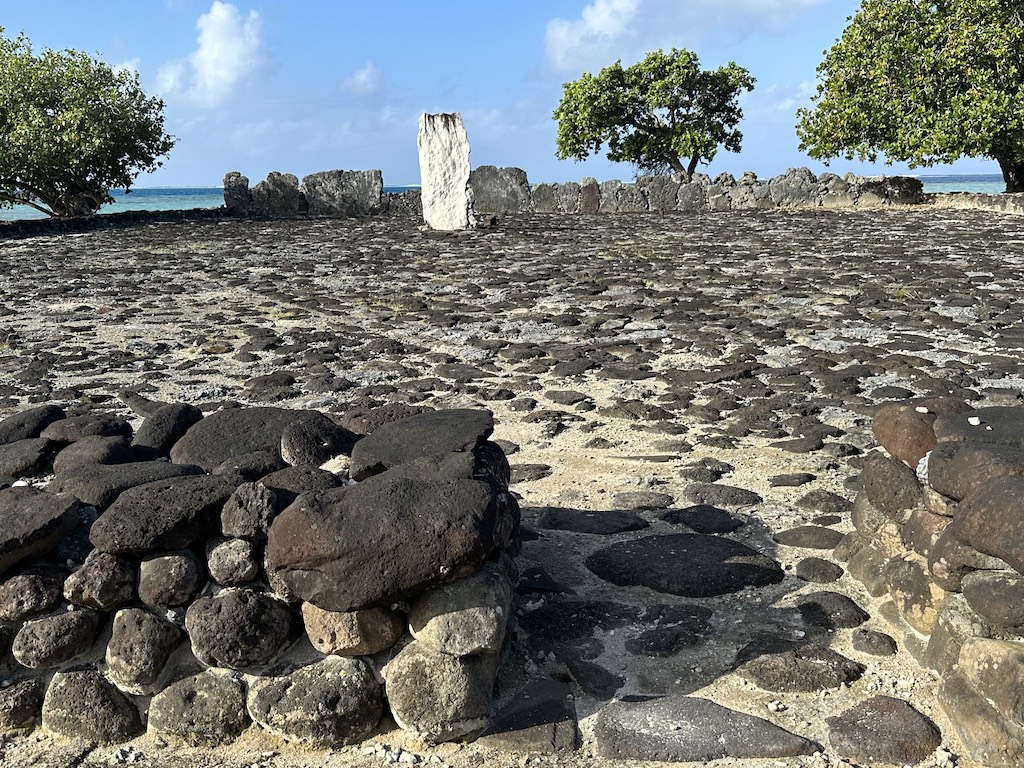
I just realised that I’ve not updated my blog for two months now – so here goes!
(For frequent videos, posted as I explored the islands, see my YouTube channel: YouTube.com/@jeannesailingsolo)
The sail to Tahanea (Tuamotus) from Ua Pou (Marquesas) in mid-July was a good one but definitely ‘boisterous’ with big, close seas tossing us around uncomfortably for most of the time.
Tahanea was as beautiful, natural and tranquil an atoll as I’d hoped and a colourful group of fishes and a black-tipped reef shark collected below Nereida during our stop there. But the weather was mostly bad and not cooperative so I actually ended up doing almost no snorkelling – not even much of the boat hull cleaning I’d expected to do.
The coral heads (aka ‘bommies’) in the anchorage caused me a big problem – my anchor chain was twice caught on them, the second time being discovered as I went to leave for Fakarava, the chain being wrapped around three different bommies. Fortunately, nearby cruisers came to my aid after I’d called on VHF 16, with a Swede and two Germans generously coming over in their two dinghies with snorkel gear. (Surprisingly, I’ve found very few cruisers seem to be using their VHF – a sign of the times, it seems.)
Having negotiated the north pass into Fakarava in fairly calm conditions, it came as a nasty surprise to find just how bad the pass could be – absolute ‘washing machine’ conditions when I left for Toau at what seemed to be about the right time – beginning of the ebb tide to coincide in direction with the prevailing SE winds…. But clearly, it was still flooding, however little, and the resultant short, steep waves in the Pass made for a difficult, very rough passage out – fortunately, not taking very long.
A similar experience was had getting into the nearby beautiful atoll of Toau, with perfect timing at slack water coming in, giving amazingly calm waters, but very, very rough conditions getting through when I left, despite some experienced cruisers just ahead of me who normally get the timing right. The tables published do not give the precise enough information that is needed for the state of tidal current in each pass – there are too many variables depending on the weather at the time. Those who advised me constantly mentioned the need to get close enough at around the right time to be able to check safely on the waters from nearby – either you’re good to go or it might be necessary to wait for up to an hour or more…. The rough waters are easily seen by the white breakers.
The reason for my unexpected sail to Toau was to see Mike - an experienced fridge tech - who found the fridge had been well over-gassed in Mexico and spent the time needed to set the gas pressure eventually at a far lower value, since when the fridge has been behaving perfectly!
I was able to tie to a UNESCO-funded mooring buoy while in Toau – put there to protect the coral around – that gave me a great feeling of security! It was also lovely to enjoy fun and games on the beach nearby with some other cruisers around. (Amazingly, one from S. Africa I had met in Cape Town some years ago!)
From Toau, I had a lovely sail south from the Tuamotus to Tahiti, in the Society Islands, under a beautiful full moon – wonderful memories are made of this!
I’d kindly been given a berth in Taina marina, near Pape’ete, where a good friend, Miky, helped me fix a jammed first reef problem, and I also got an instrument problem resolved by Manatea – thanks to both! With other cruisers I’d met both in Ua Pou and again in Tahanea, we hired a car and made a lovely tour of Tahiti island. This was not something I’d done previously and the newly-renovated museum was well worth spending plenty of time in, in addition to enjoying the often-rugged scenery everywhere. Of course, I was able to stock up on French cheeses, pate and cream, etc, etc while in Marina Taina!
On to dramatic Opunohu Bay in Mo’orea for a quick overnight stop with good timing, arriving just at sunset. I could not believe how many yachts were around this area. The last time (in 2007!) I’d been here, it had been so very tranquil with just myself and one other boat in the bay – and no cars whizzing around on the shore road nearby!
Another ‘boisterous’, fast sail followed, this time to lovely Huahine which I’d missed seeing on my last time here. This was a highly worthwhile stop, over my well-celebrated birthday - the friends I had met up with in Toau made sure of that! Inside the reef at the south end of Huahine is a large, well-protected spot, again supplied with mooring buoys. As I came in, a fellow-cruiser came rushing over to help tie up to the buoy – and he later spent a lot of time getting my dinghy outboard working again – thanks so much to yet another cruiser doing a fellow cruiser a good turn!
On trying to leave Huahine for nearby Raiatea (an easy pleasant day sail away), I discovered the loop of the buoy was rough and was not allowing my two lines tied to our bow to slip through – I was again stuck, with no response to my calls to nearby boats on VHF 16, until another cruiser friend, fortunately anchored not too far away, eventually came by, after hearing me not getting any answers, and released the lines from his dinghy.
What a lovely island Raiatea turned out to be with friendly, smiling people, so many dramatic rugged mountains, long peaceful beaches lining deep inlets and colourful flowers along the roads everywhere! I discovered it was the original, historic starting point for the Polynesian ‘explosion’ to the surrounding South Pacific islands (including, eventually, to New Zealand - but only relatively recently arriving there.). Again I hired a car since, while I could hitch-hike into the nearby town of Uturoa, there were no buses to enable me to explore the island unless on a tour – which was proving difficult to organise.
A ’must-see’ was the historic Marae at Tiputipuatea, down in the SE of the island on a long promontory. I spent plenty of time there, sensing the generations of Polynesians who had gathered in this place and, next morning, climbed the steep hill above it to look over the site and its nearby coast.
I had a major problem with my windlass, essential for raising the anchor, and I also managed to lose two boat hooks, at different times, while trying to pick up some ‘unfriendly’ buoys. I’m used to nice, lightweight ‘pick-up’ buoys which are relatively easy to pick up, even I’m when alone on the boat – but there seemed to be none of those, nor an easy alternative. Thank goodness, Thierry managed to fix the windlass problems, mainly due to two diodes needing replacing, rather than having to replace the entire unit – that was excellent news!
I ended my time in French Polynesia on Taha’a, the island north of Raiatea that shares the same fringing reef. Before leaving, I anchored off its so-called ‘Coral Garden’ which makes for a great snorkel, drifting in the quite strong current between two ‘motus’ (small coral islands) on the incoming current. The coral, sadly, was mostly dead from the many tourists snorkelling over it, with occasional clumps looking fine – mostly in the areas where the reef grew higher, coming so close to the water surface that it left too little water above it to swim or snorkel in. However, there were lots of different fish of all colours, shapes and sizes, along with dark sea slugs and enormous clams, clearly very old, as well as big clumps of sea anemones with their accompanying bright little fishes.
I could have easily spent more time in all the very different parts of French Polynesia – but my visa only gave me three months so, on 4thSeptember, I set sail for the Cook Islands and then Tonga. At least, that was the original plan – but plans have a habit of changing…. “Plans made in wet sand at low water” don’t last long. The bad weather forecast for some days ahead made Samoa look very much like a better option than Tonga direct as I started out heading due west but that soon changed and I felt able to continue W towards Tonga, skipping the Cooks as too difficult to clear in to plus the weather was forecast to deteriorate if I paused on the way to Tonga..
As I sailed on, I found my first reef problem seemed to have returned – I couldn’t budge the line to take in the first reef when the wind got up. I dropped the mainsail anyway and took in the second reef (and more!) in a hurry one night when the wind rose from nothing to well over 20 knots in no time. The other worrying problem was that when the main engine was running, it was clearly not charging the batteries – its belt could be heard squealing and slipping badly and it seemed to have come out of place on a drive wheel.
I suddenly realised that I was heading almost directly to the little atoll of Aitutaki where I had previously considered stopping. By pausing there now, while some very wet and windy weather was forecast to pass by also, I could hopefully fix both problems … and see something of what was reputed to be a beautiful and friendly place. So I did,,, and I did … and it was… !!
The entry channel into Aitutaki harbour is VERY narrow and not quite straight, leading in for a good distance between shallows of about one foot depth – a mind-concentrating exercise to get through safely without running aground. Talk about white knuckles gripping the steering wheel… those were mine as I stood on tiptoes to see ahead, trying to figure out where best to head for the deepest water!
I spent most of a day sorting out my misbehaving reef line and then tidying up other lines on deck and another cruiser, Colin, came by, just before I left, with the necessary engineer’s expertise to fix my alternator bracket, which had effectively fallen to bits with five bolts and a backing plate completely having come away. Eventually, he replaced the alternator and its belt firmly in place – so the engine is now charging again!
In between times, my anchor dragged in the shallow, tiny basin and had to be re-set – with help from my neighbouring cruisers - and a deep-draught (3m/10ft!) boat came in soon after Sunday’s heavy deluge and managed to go aground. It took a lot of effort from others to help free the boat which then went to tie up to the local wharf – just scraping in at High Water
Watching all those high jinks was Mike – a New Zealander on a fishing trip – who later got in contact with me and offered to show me around the island. Accepting his offer with delight, I had a grand tour of everything the island has to offer, including a lovely lunch at an impressive island resort hotel. Wild pigs, goats, reef herons and egrets, fascinating old worn coral beaches, wonderful white sand beaches looking over the vivid blue of shallows towards the fringing reef with its white foaming breakers, driving along tracks through some dense wild forest with a lot of large crab holes (and crabs!) beside the road, impressive ‘curtain vines’ dangling from high up on a group of (wild fig?) trees …. None of the rain still falling that day could spoil what I was shown!
Suddenly, that evening, I saw a weather window which meant I had to organise clearing out of the Cooks the following day, ready to sail for Tonga in good weather – initially, at least …. (making sure to be ready to leave the harbour at 9a.m. - High Water). Correction – I hoped to make for Beveridge Reef which is (almost) on the way from Aitutaki to Vava’u (in Tonga). As I was leaving shore after clearing out, Mike came by with some wonderful mahi-mahi he’d caught that day which made a lovely meal later and while I was on passage!
The weather has continued to be difficult, although my sail since leaving Aitutaki yesterday morning has been great, with good winds, but grey skies, yesterday and sunshine with rather lighter winds today – possibly dying further. Then it’s possible that I’ll reach Beveridge Reef in quickly-increasing winds on Sunday, set to become very strong. So it seems I may or may not reach Beveridge Reef in time as another bout of bad weather arrives and I’m likely to have to stay for a few days inside the safe waters of what is effectively an atoll lying mostly just under the sea surface, before continuing on to Vava’u in lighter conditions. The next few days will tell…..
In the meantime, that wind seems to be getting even lighter…. Time to download the latest weather forecasts.The Tuamotus and Societies of French Polynesia over 14 July – 4 September 2023 …and on Westward
14 September 2023
I’ve just realised that I’ve not updated my blog for two months now – so here goes!
(For frequent videos, posted as I explored the islands, see my YouTube channel: YouTube.com/@jeannesailingsolo)
The sail to Tahanea (Tuamotus) from Ua Pou (Marquesas) in mid-July was a good one but definitely ‘boisterous’ with big, close seas tossing us around for most of the time.
Tahanea was as beautiful, natural and tranquil an atoll as I’d hoped and a colourful group of fishes and a black-tipped reef shark collected underNereidaduring our stop there. But the weather was mostly bad and not cooperative so I actually ended up doing almost no snorkelling – not even much of the boat hull cleaning I’d expected to do. The coral heads (aka ‘bommies’) in the anchorage caused me a big problem – my anchor chain was twice caught on them, the second time being discovered as I went to leave for Fakarava, the chain being wrapped around three different bommies. Fortunately, nearby cruisers came to my aid after I’d called on VHF 16, with a Swede and two Germans generously coming over in their two dinghies with snorkel gear. (Surprisingly, I’ve found very few cruisers seem to be using their VHF – a sign of the times, it seems.)
Having negotiated the north pass into Fakarava in fairly calm conditions, it came as a nasty surprise to find just how bad the pass could be – absolute ‘washing machine’ conditions when I left for Toau at what was meant to be about the right time – beginning of the ebb tide to coincide in direction with the prevailing SE winds…. But clearly, it was still flooding, however little, and the resultant short, steep waves in the Pass made for a difficult, very rough passage out – fortunately, not for very long.
A similar experience was had getting into the nearby beautiful atoll of Toau, with perfect timing of slack water coming in and amazingly calm waters but very, very rough conditions getting through when I left, despite some experienced cruisers just ahead of me who normally get the timing right. The tables published do not give the precise enough information that is needed for the state of tidal current in each pass – there are too many variables depending on the weather at the time. Those who advised me constantly mentioned the need to get close enough at around the right time to be able to check safely on the waters from nearby – either you’re good to go or it might be necessary to wait for up to an hour or more…. The rough waters are easily seen by the white breakers.
The reason for my unexpected sail to Toau was to see Mike - an experienced fridge tech - who found the fridge had been well over-gassed in Mexico and spent the time needed to set the gas pressure eventually at a far lower value, since when the fridge has been behaving perfectly!
I was able to tie to a UNESCO-funded mooring buoy while in Toau – put there to protect the coral around – that gave me a great feeling of security! It was also lovely to enjoy fun and games on the beach nearby with some other cruisers around. (Amazingly, one from S. Africa I had met in Cape Town some years ago!)
From Toau, I had a lovely sail south from the Tuamotus to Tahiti, in the Society Islands, under a beautiful full moon – wonderful memories are made of this!
I’d kindly been given a berth in Taina marina, near Pape’ete, where a good friend, Miky, helped me fix a jammed first reef problem, and I also got an instrument problem resolved by Manatea – thanks to both! With other cruisers I’d met both in Ua Pou and again in Tahanea, we hired a car and made a lovely tour of Tahiti island. This was not something I’d done previously and the newly-renovated museum was well worth spending plenty of time in, in addition to enjoying the often-rugged scenery everywhere. Of course, I was able to stock up on French cheeses, pate and cream, etc, etc while in Marina Taina!
On to dramatic Opunohu Bay in Mo’orea for a quick overnight stop with good timing, arriving just at sunset. I could not believe how many yachts were around this area. The last time (in 2007!) I’d been here, it had been so very tranquil with just myself and one other boat in the bay – and no cars whizzing around on the shore road nearby!
Another ‘boisterous’, fast sail followed, this time to lovely Huahine which I’d missed seeing on my last time here. This was a highly worthwhile stop, over my well-celebrated birthday - the friends I had met up with in Toau made sure of that! Inside the reef at the south end of Huahine is a large, well-protected spot, again supplied with mooring buoys. As I came in, a fellow-cruiser came rushing over to help tie up to the buoy – and he later spent a lot of time getting my dinghy outboard working again – thanks so much to yet another cruiser doing a fellow cruiser a good turn!
On trying to leave Huahine for nearby Raiatea (an easy pleasant day sail away), I discovered the loop of the buoy was rough and was not allowing my two lines tied to our bow to slip through – I was again stuck, with no response to my calls to nearby boats on VHF 16, until another cruiser friend, fortunately anchored not too far away, eventually came by, after hearing me not getting any answers, and released the lines from his dinghy.
What a lovely island Raiatea turned out to be with friendly, smiling people, so many dramatic rugged mountains, long peaceful beaches lining deep inlets and colourful flowers along the roads everywhere! I discovered it was the original, historic starting point for the Polynesian ‘explosion’ to the surrounding South Pacific islands (including, eventually, to New Zealand - but only relatively recently arriving there.). Again I hired a car since, while I could hitch-hike into the nearby town of Uturoa, there were no buses to enable me to explore the island unless on a tour – which was proving difficult to organise.
A ’must-see’ was the historic Marae at Tiputipuatea, down in the SE of the island on a long promontory. I spent plenty of time there, sensing the generations of Polynesians who had gathered in this place and, next morning, climbed the steep hill above it to look over the site and its nearby coast.
I had a major problem with my windlass, essential for raising the anchor, and I also managed to lose two boat hooks, at different times, while trying to pick up some ‘unfriendly’ buoys. I’m used to nice, lightweight ‘pick-up’ buoys which are relatively easy to pick up, even I’m when alone on the boat – but there seemed to be none of those, nor an easy alternative. Thank goodness, Thierry managed to fix the windlass problems, mainly due to two diodes needing replacing, rather than having to replace the entire unit – that was excellent news!
I ended my time in French Polynesia on Taha’a, the island north of Raiatea that shares the same fringing reef. Before leaving, I anchored off its so-called ‘Coral Garden’ which makes for a great snorkel, drifting in the quite strong current between two ‘motus’ (small coral islands) on the incoming current. The coral, sadly, was mostly dead from the many tourists snorkelling over it, with occasional clumps looking fine – mostly in the areas where the reef grew higher, coming so close to the water surface that it left too little water above it to swim or snorkel in. However, there were lots of different fish of all colours, shapes and sizes, along with dark sea slugs and enormous clams, clearly very old, as well as big clumps of sea anemones with their accompanying bright little fishes.
I could have easily spent more time in all the very different parts of French Polynesia – but my visa only gave me three months so, on 4thSeptember, I set sail for the Cook Islands and then Tonga. At least, that was the original plan – but plans have a habit of changing…. “Plans made in wet sand at low water” don’t last long. The bad weather forecast for some days ahead made Samoa look very much like a better option than Tonga direct as I started out heading due west but that soon changed and I felt able to continue W towards Tonga, skipping the Cooks as too difficult to clear in to plus the weather was forecast to deteriorate if I paused on the way to Tonga..
As I sailed on, I found my first reef problem seemed to have returned – I couldn’t budge the line to take in the first reef when the wind got up. I dropped the mainsail anyway and took in the second reef (and more!) in a hurry one night when the wind rose from nothing to well over 20 knots in no time. The other worrying problem was that when the main engine was running, it was clearly not charging the batteries – its belt could be heard squealing and slipping badly and it seemed to have come out of place on a drive wheel.
I suddenly realised that I was heading almost directly to the little atoll of Aitutaki where I had previously considered stopping. By pausing there now, while some very wet and windy weather was forecast to pass by also, I could hopefully fix both problems … and see something of what was reputed to be a beautiful and friendly place. So I did,,, and I did … and it was… !!
The entry channel into Aitutaki harbour is VERY narrow and not quite straight, leading in for a good distance between shallows of about one foot depth – a mind-concentrating exercise to get through safely without running aground. Talk about white knuckles gripping the steering wheel… those were mine as I stood on tiptoes to see ahead, trying to figure out where best to head for the deepest water!
I spent most of a day sorting out my misbehaving reef line and then tidying up other lines on deck and another cruiser, Colin, came by, just before I left, with the necessary engineer’s expertise to fix my alternator bracket, which had effectively fallen to bits with five bolts and a backing plate completely having come away. Eventually, he replaced the alternator and its belt firmly in place – so the engine is now charging again!
In between times, my anchor dragged in the shallow, tiny basin and had to be re-set – with help from my neighbouring cruisers - and a deep-draught (3m/10ft!) boat came in soon after Sunday’s heavy deluge and managed to go aground. It took a lot of effort from others to help free the boat which then went to tie up to the local wharf – just scraping in at High Water
Watching all those high jinks was Mike – a New Zealander on a fishing trip – who later got in contact with me and offered to show me around the island. Accepting his offer with delight, I had a grand tour of everything the island has to offer, including a lovely lunch at an impressive island resort hotel. Wild pigs, goats, reef herons and egrets, fascinating old worn coral beaches, wonderful white sand beaches looking over the vivid blue of shallows towards the fringing reef with its white foaming breakers, driving along tracks through some dense wild forest with a lot of large crab holes (and crabs!) beside the road, impressive ‘curtain vines’ dangling from high up on a group of (wild fig?) trees …. None of the rain still falling that day could spoil what I was shown!
Suddenly, that evening, I saw a weather window which meant I had to organise clearing out of the Cooks the following day, ready to sail for Tonga in good weather – initially, at least …. (making sure to be ready to leave the harbour at 9a.m. - High Water). Correction – I hoped to make for Beveridge Reef which is (almost) on the way from Aitutaki to Vava’u (in Tonga). As I was leaving shore after clearing out, Mike came by with some wonderful mahi-mahi he’d caught that day which made a lovely meal later and while I was on passage!
The weather has continued to be difficult, although my sail since leaving Aitutaki yesterday morning has been great, with good winds, but grey skies, yesterday and sunshine with rather lighter winds today – possibly dying further. Then it’s possible that I’ll reach Beveridge Reef in quickly-increasing winds on Sunday, set to become very strong. So it seems I may or may not reach Beveridge Reef in time as another bout of bad weather arrives and I’m likely to have to stay for a few days inside the safe waters of what is effectively an atoll lying mostly just under the sea surface, before continuing on to Vava’u in lighter conditions. The next few days will tell…..
In the meantime, that wind seems to be getting even lighter…. Time to download the latest weather forecasts.


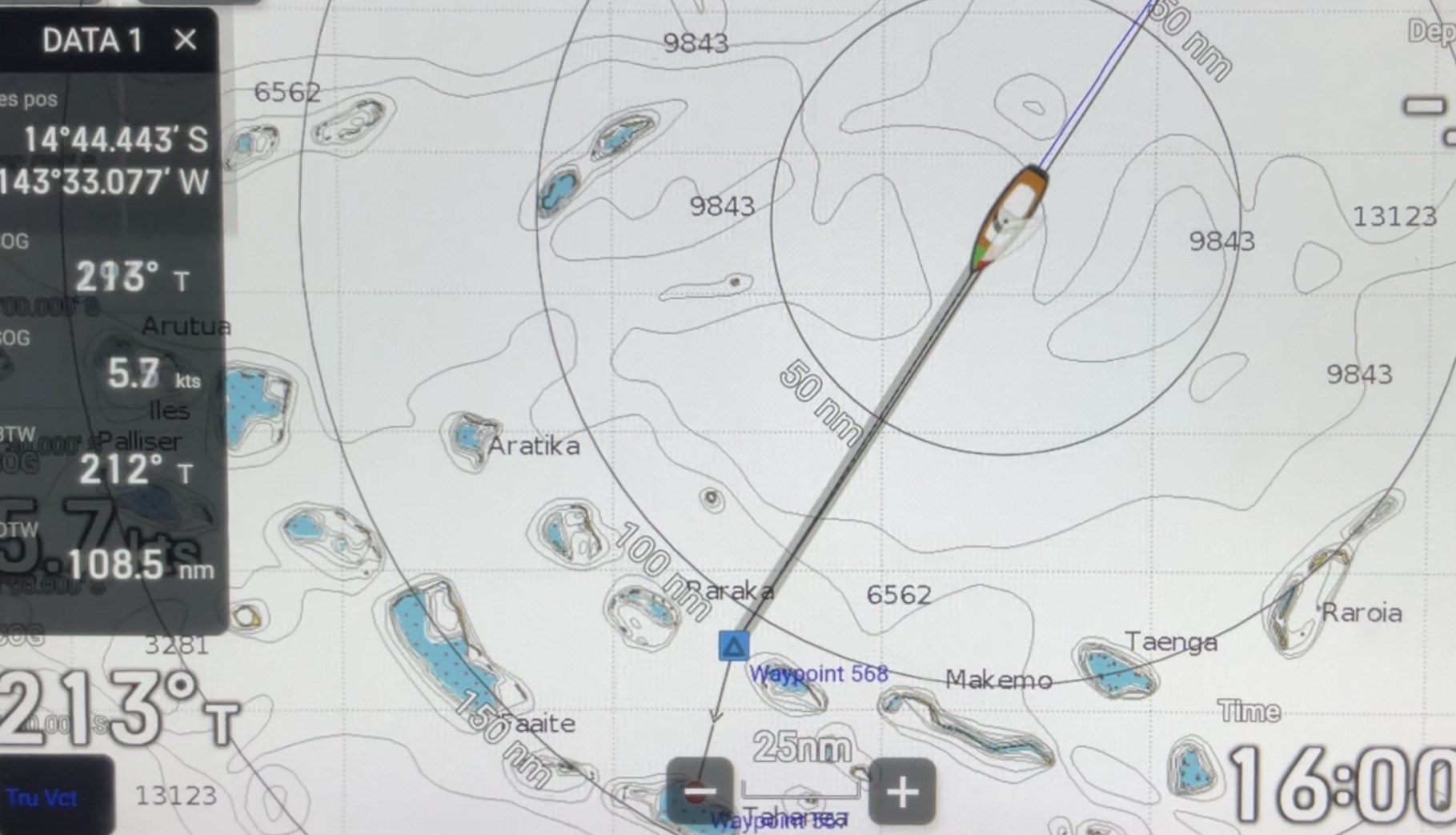
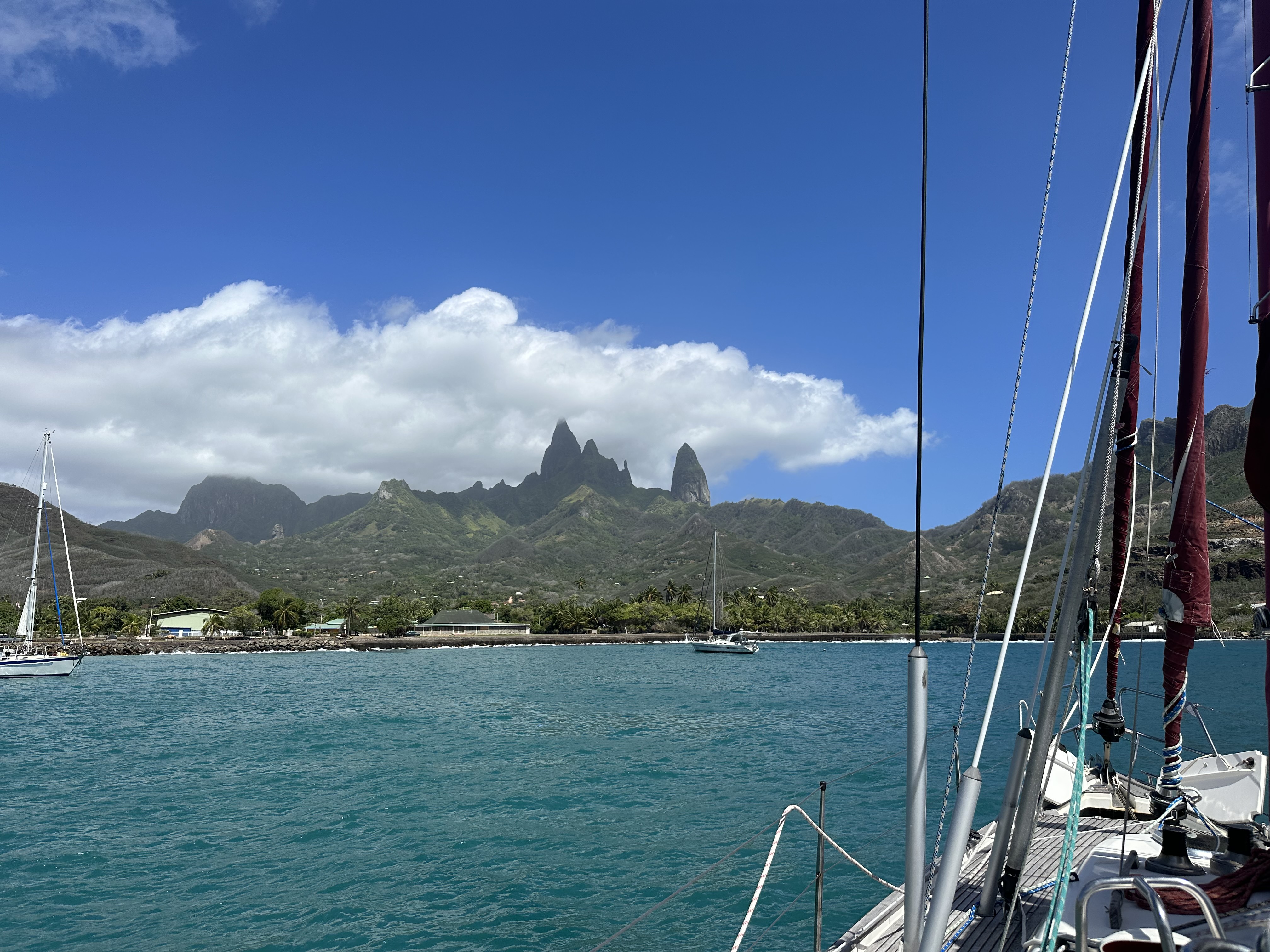
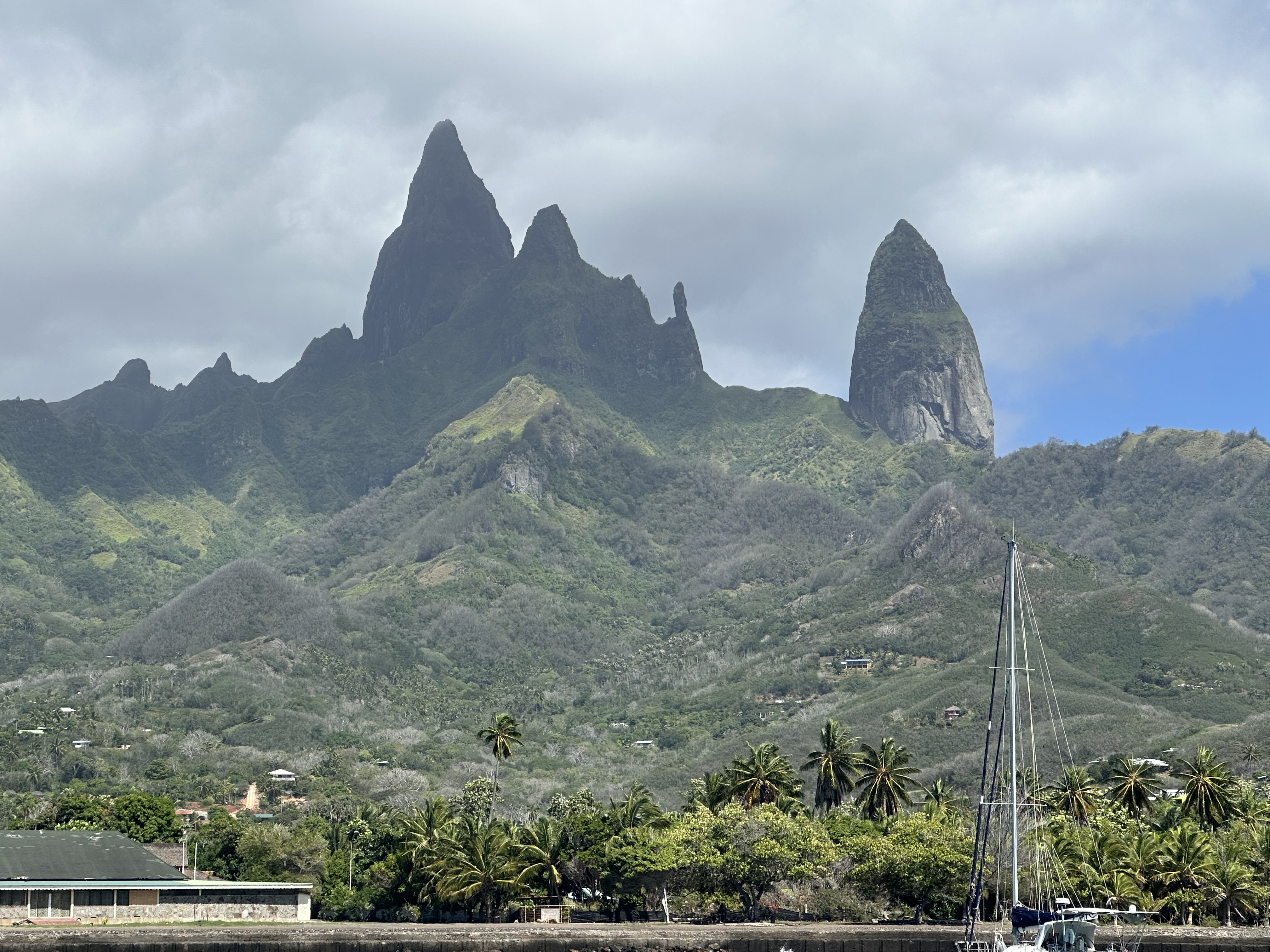
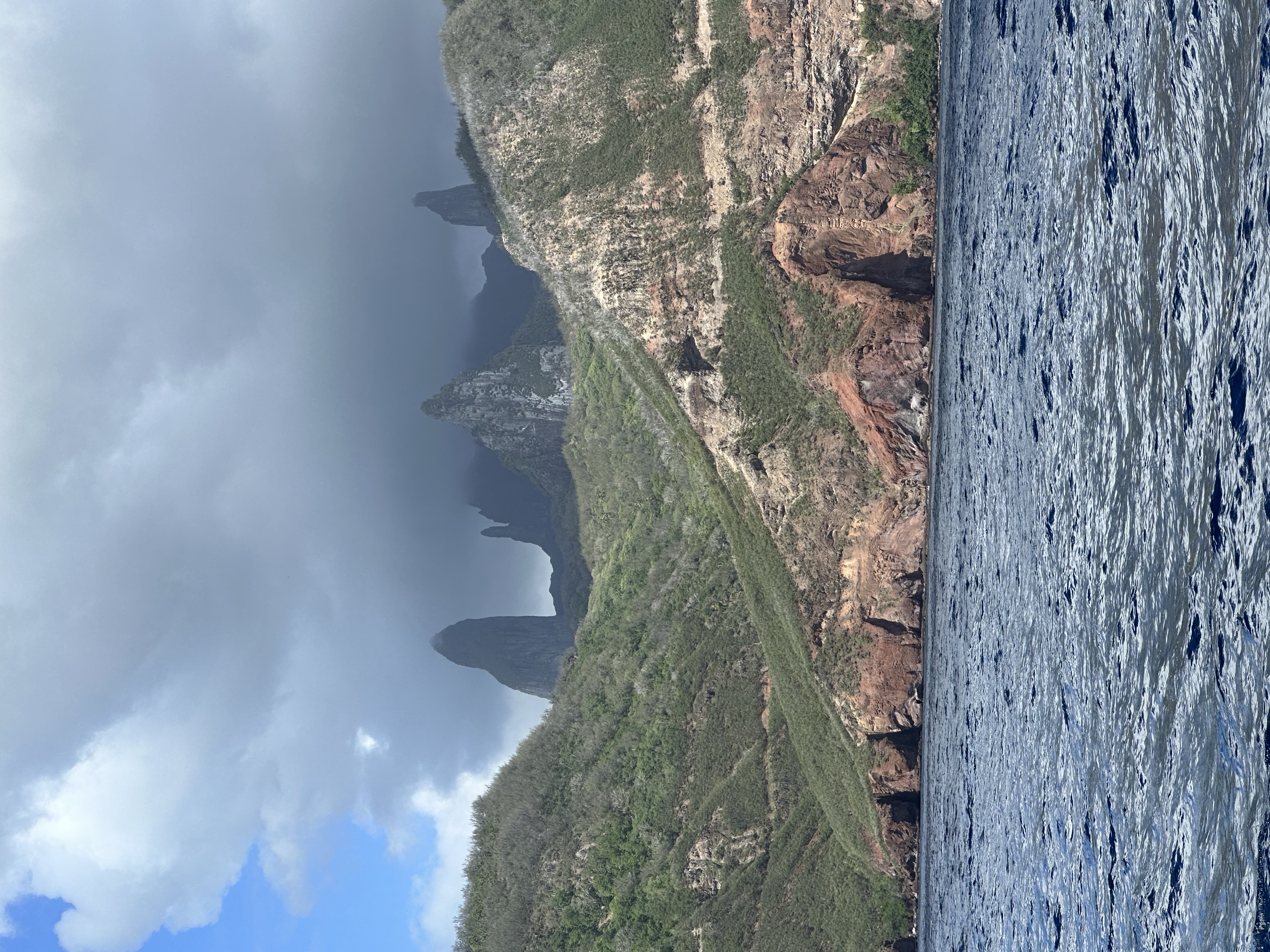
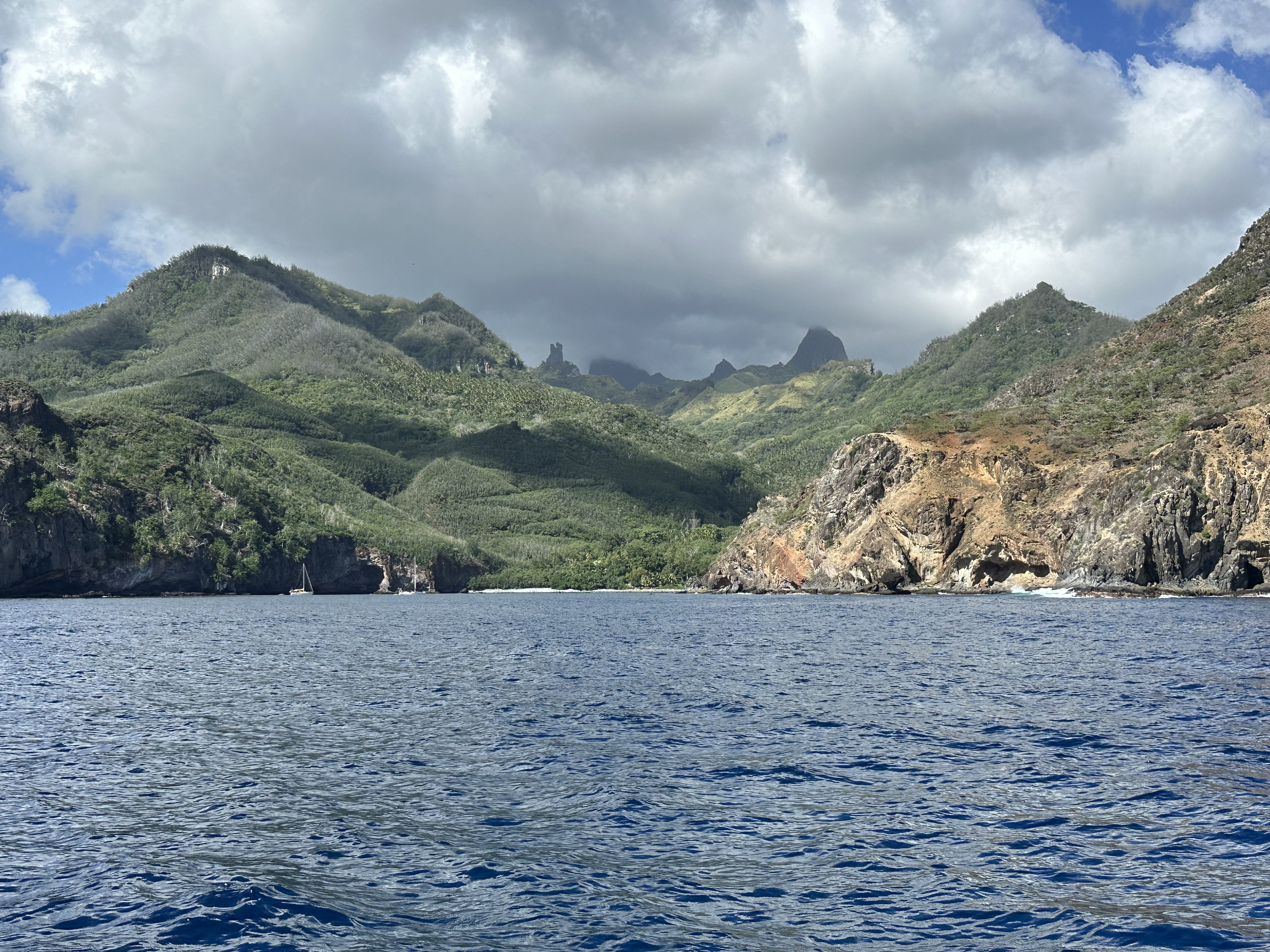
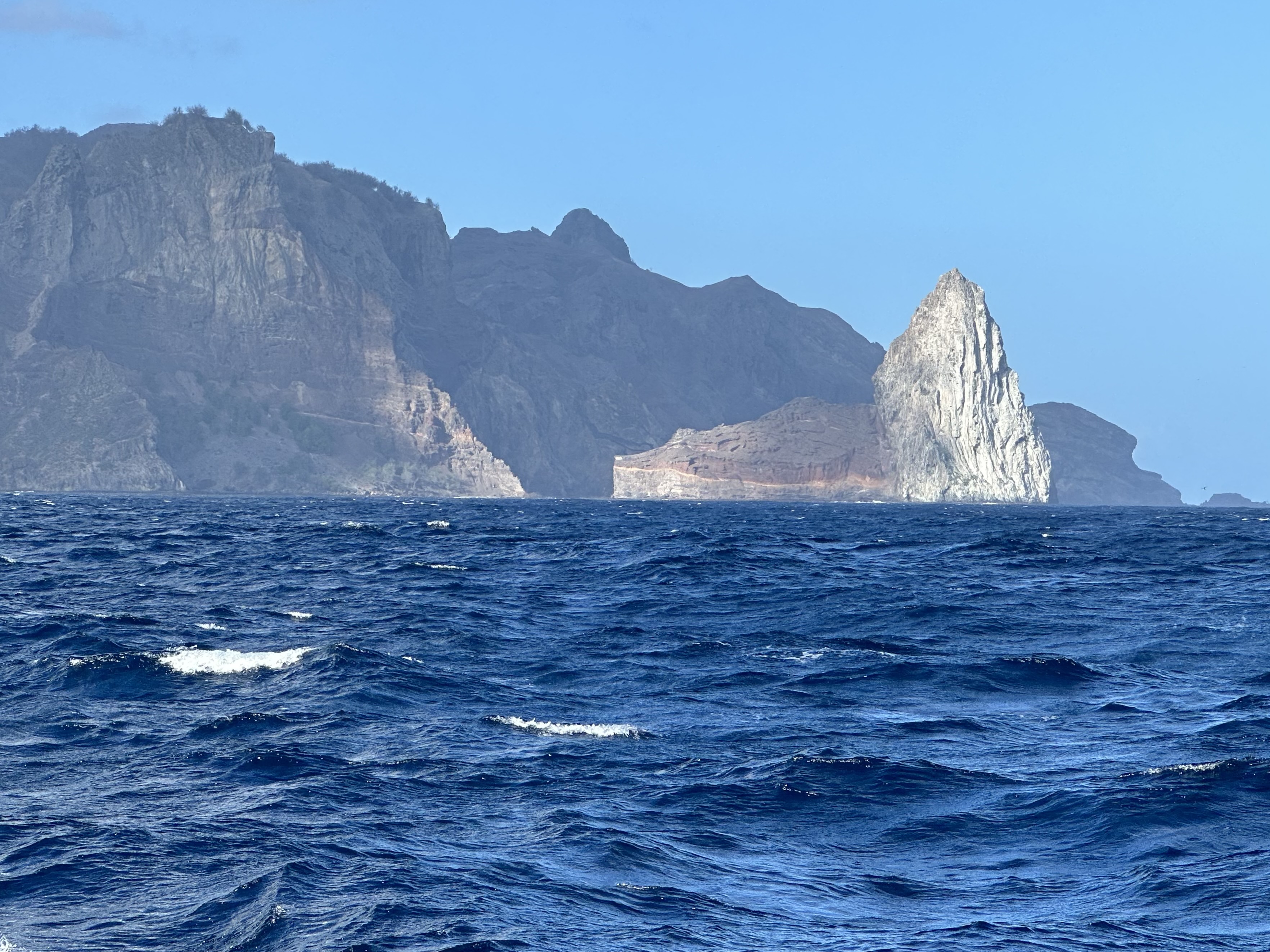
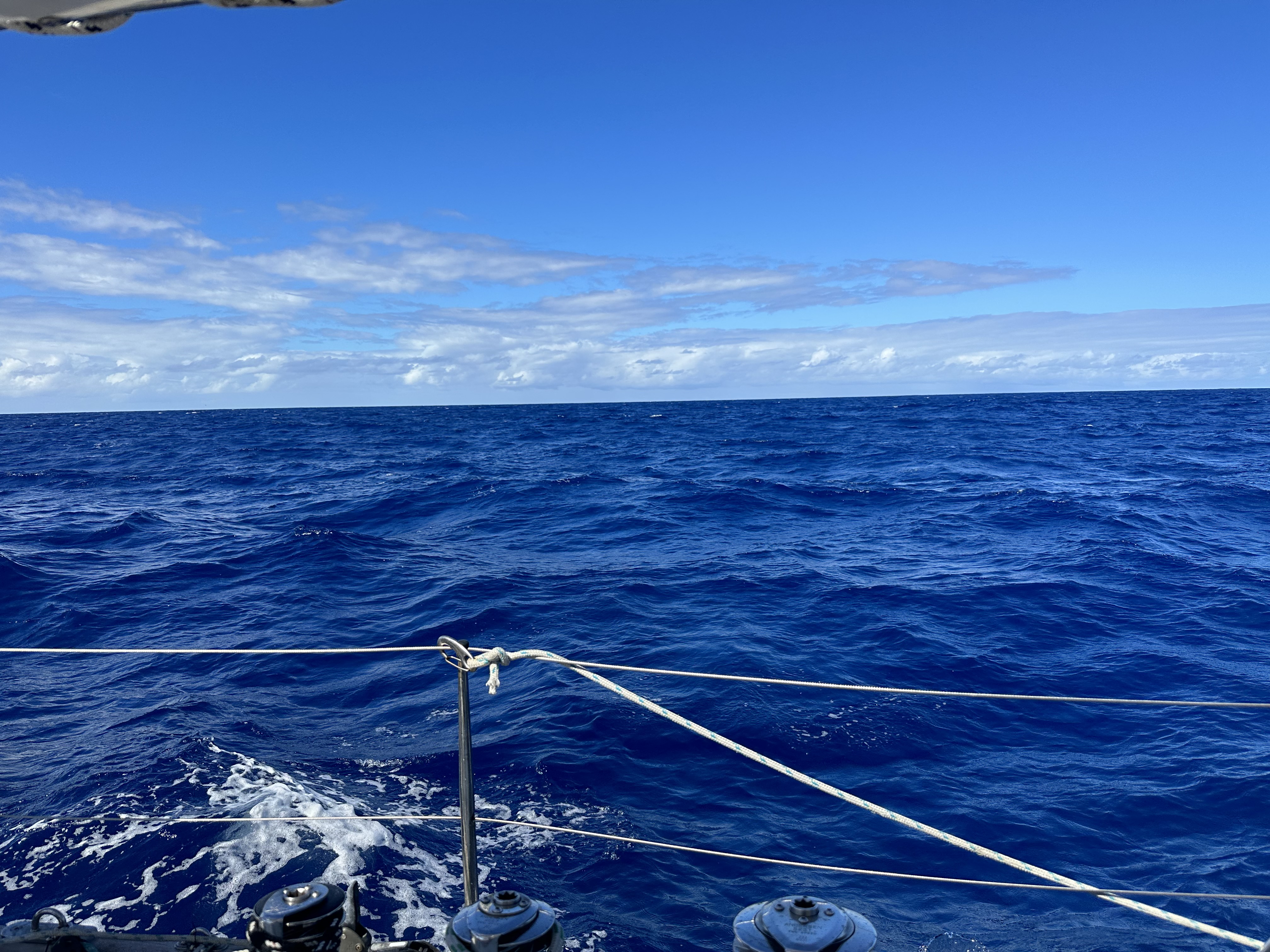
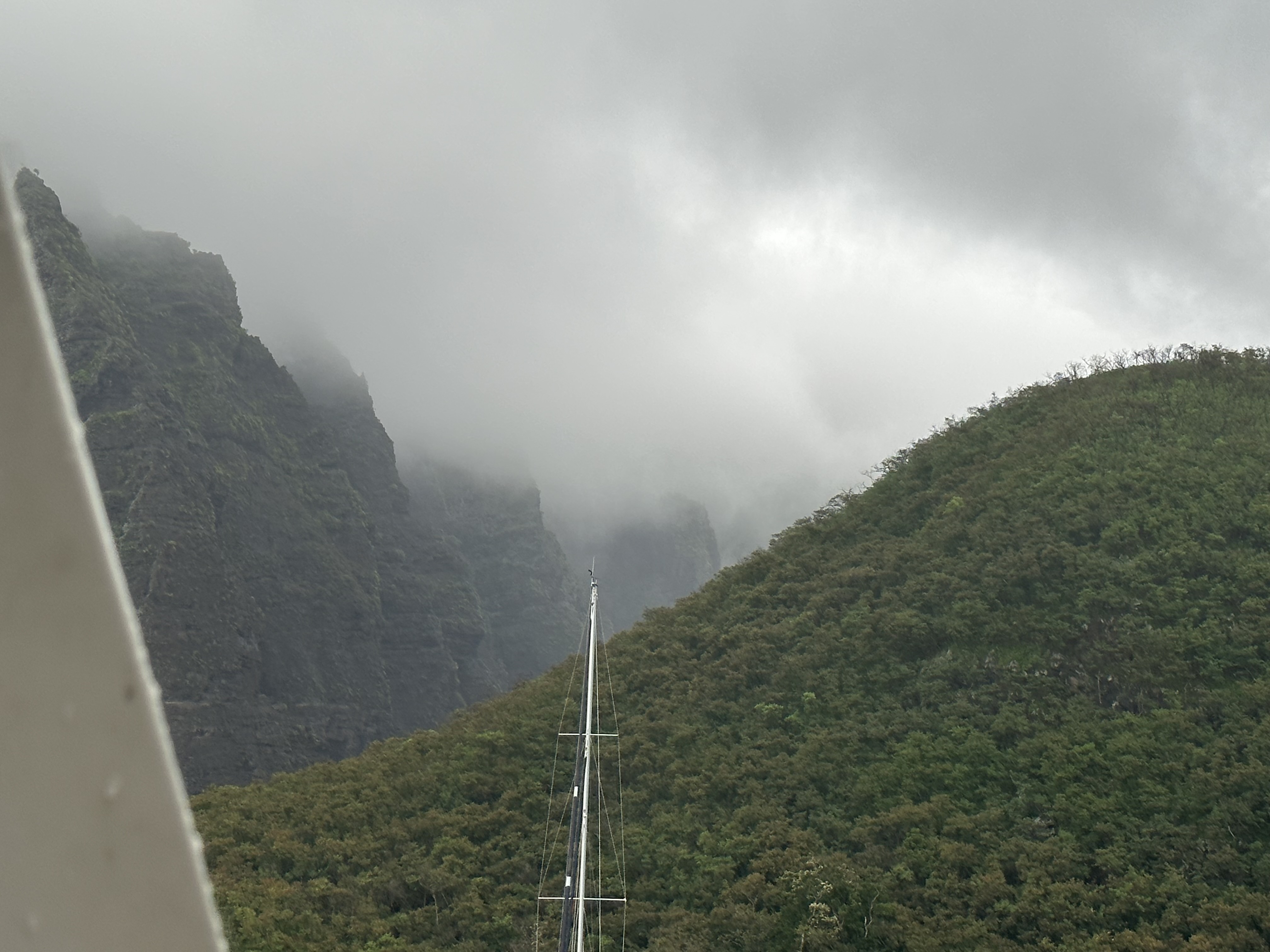
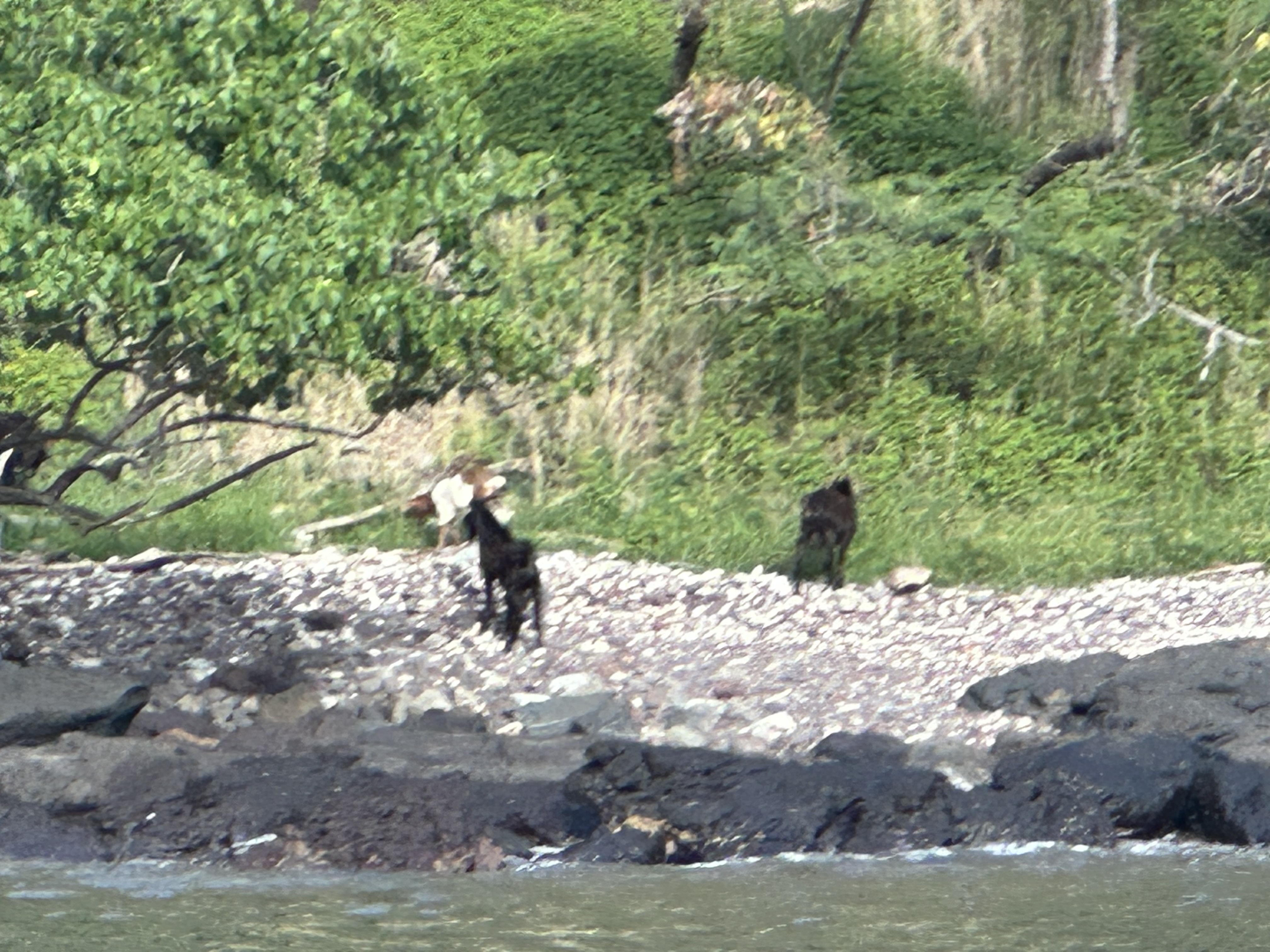
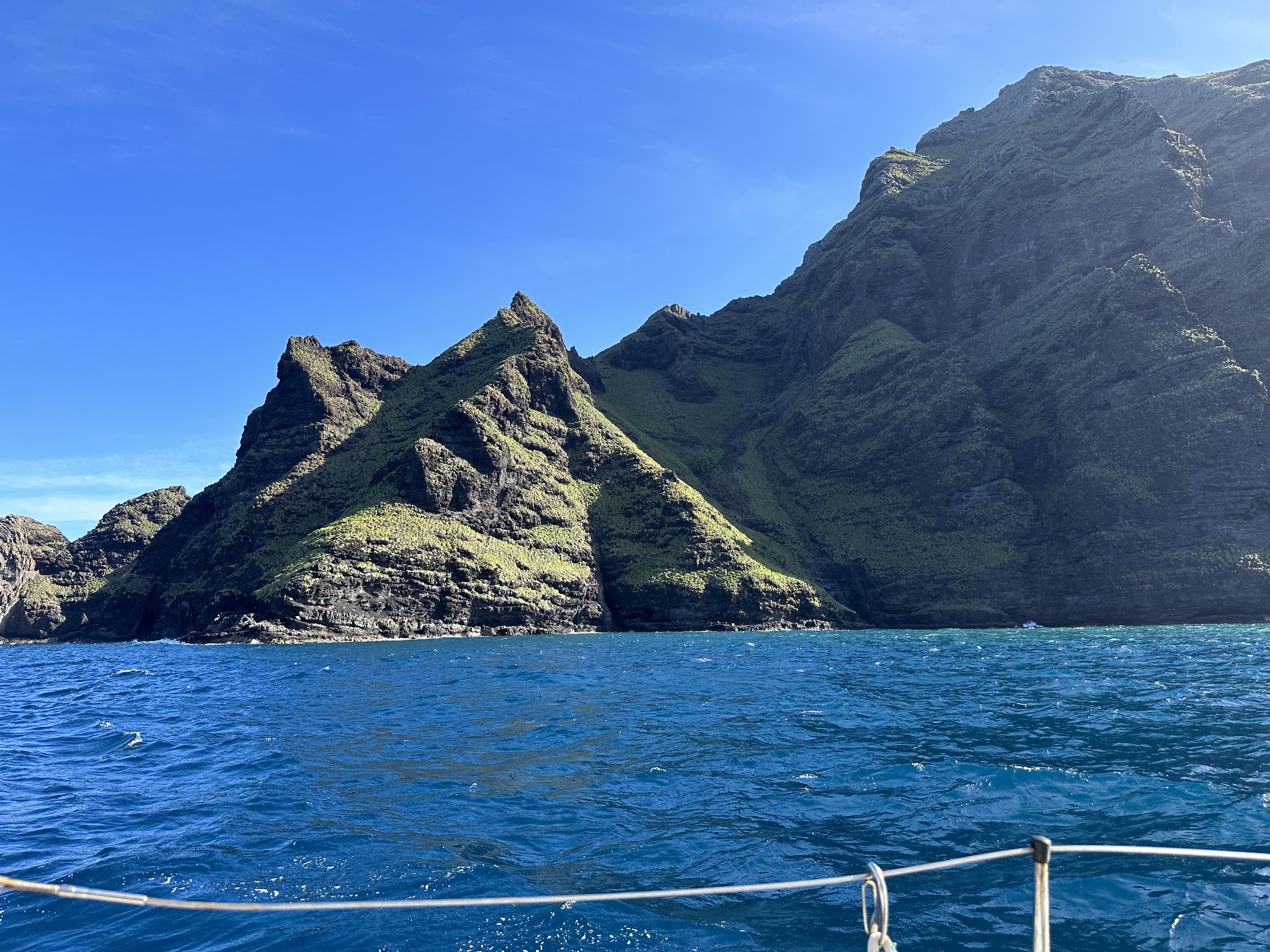
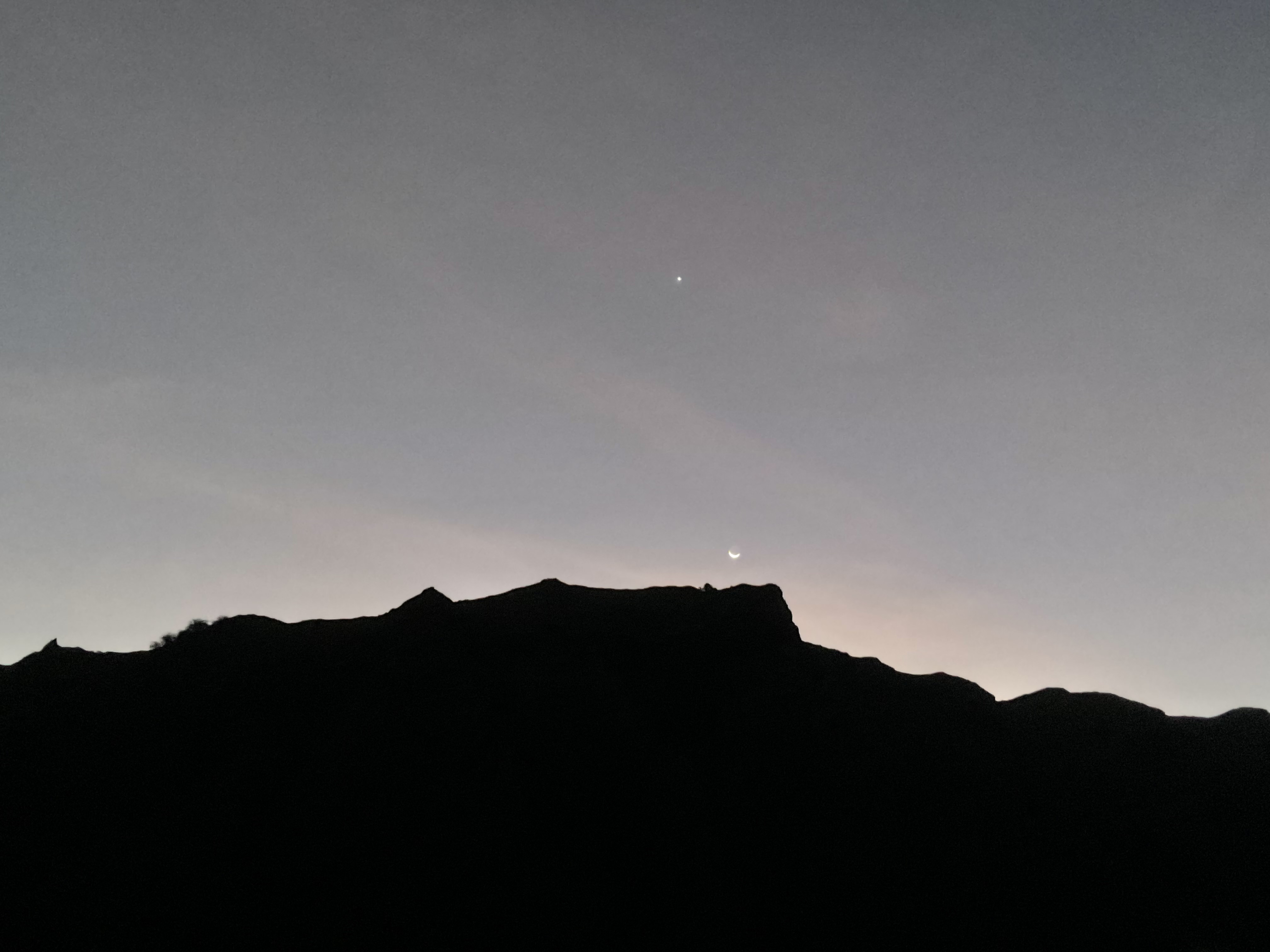
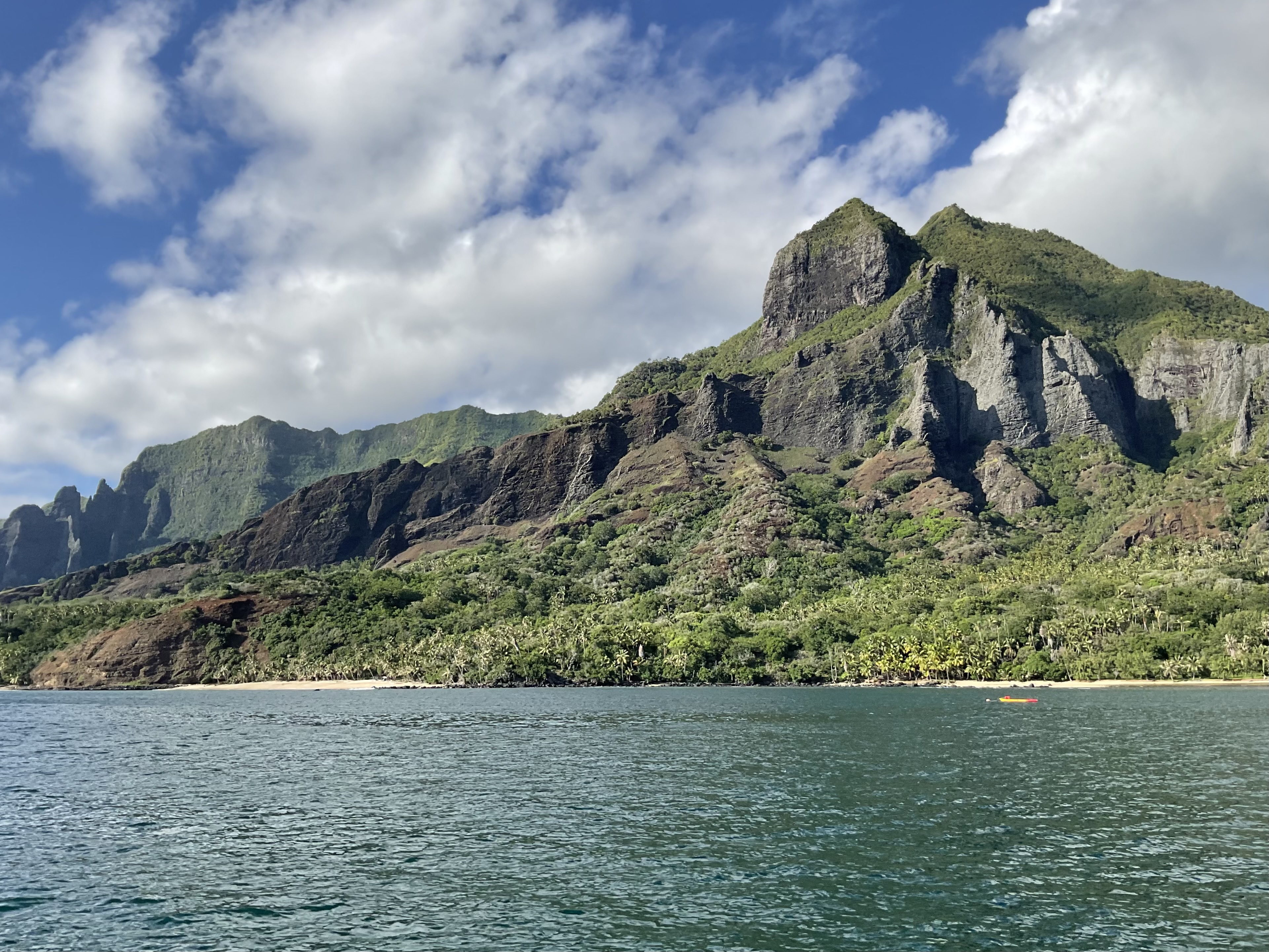
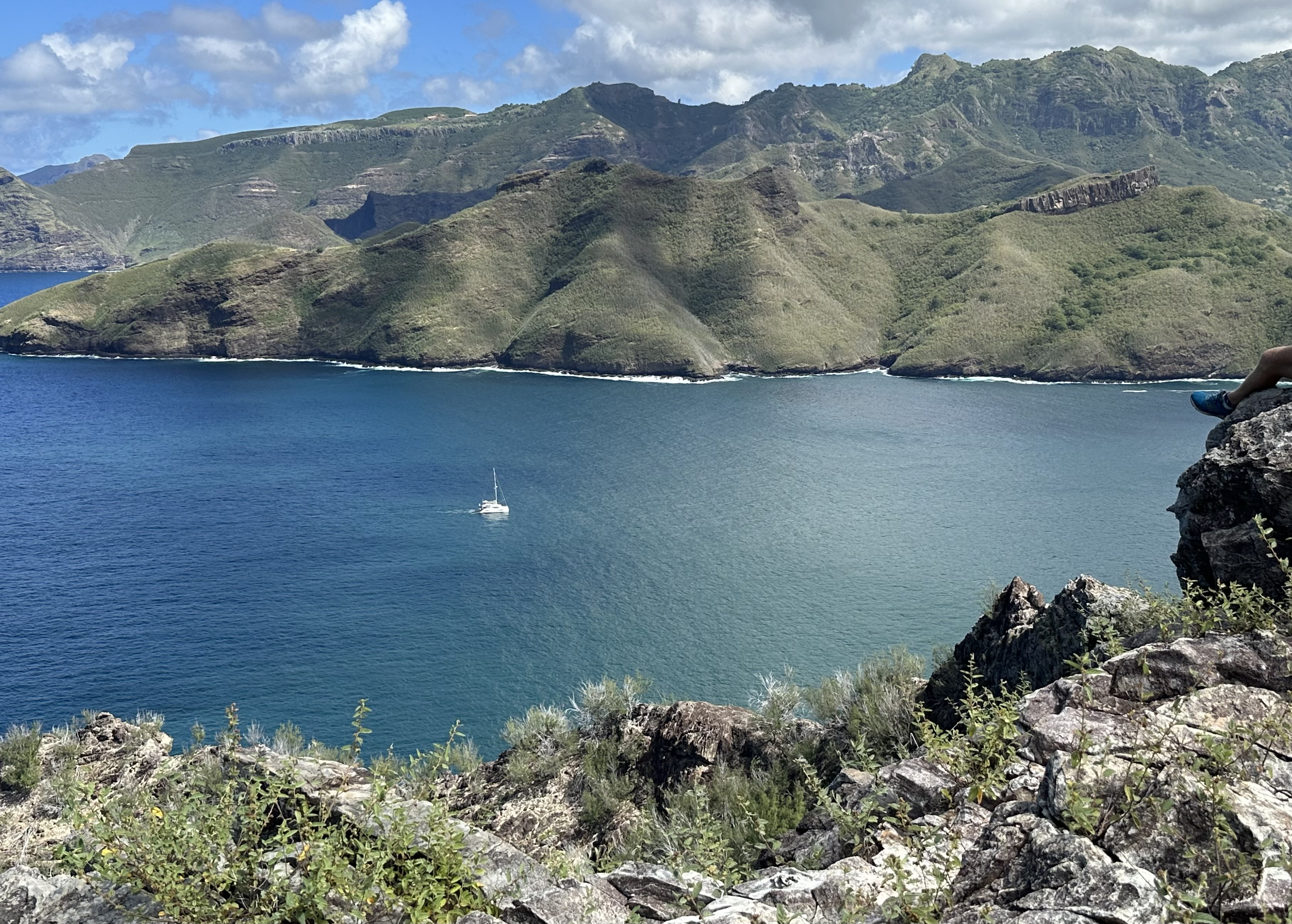
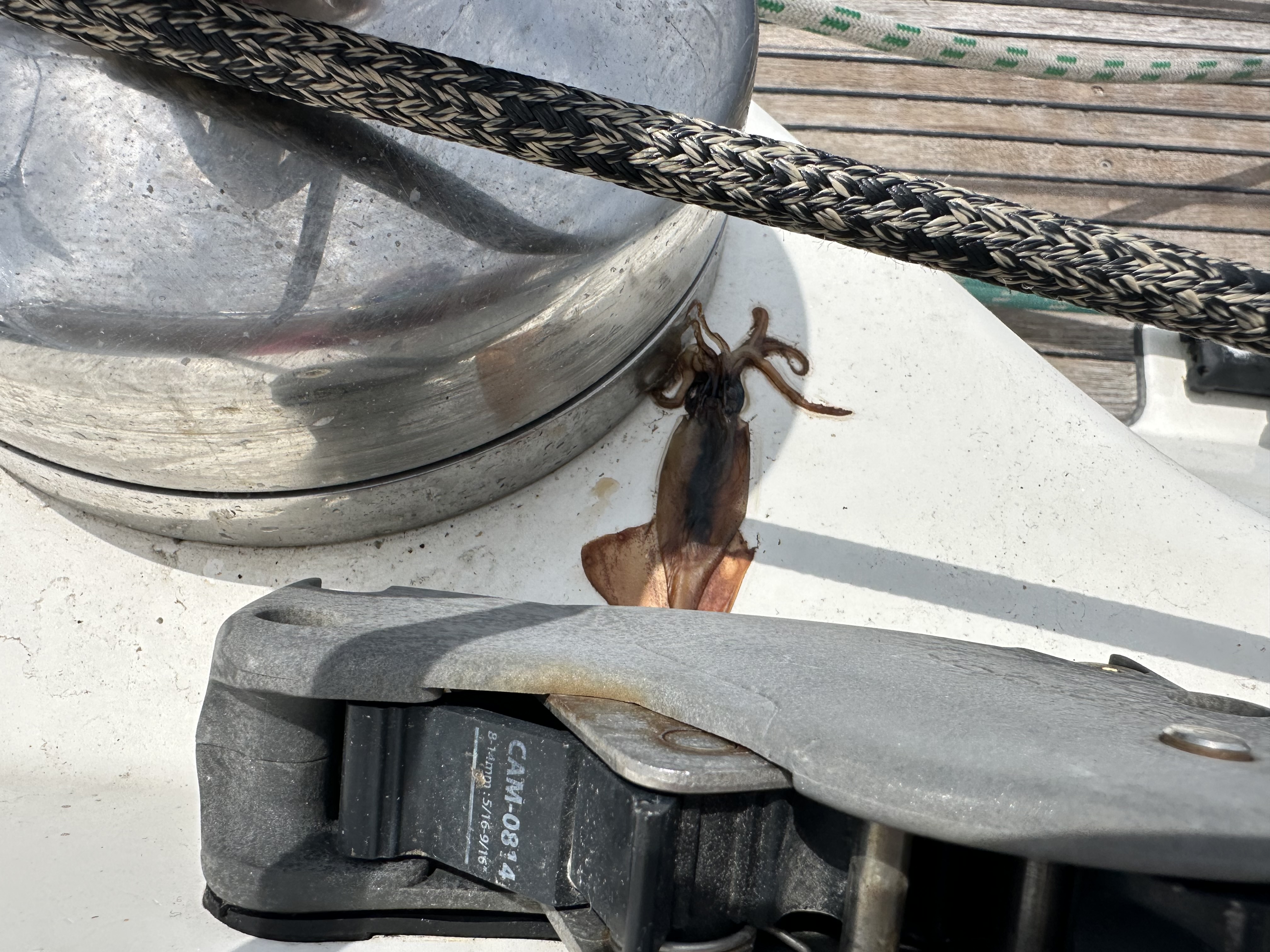

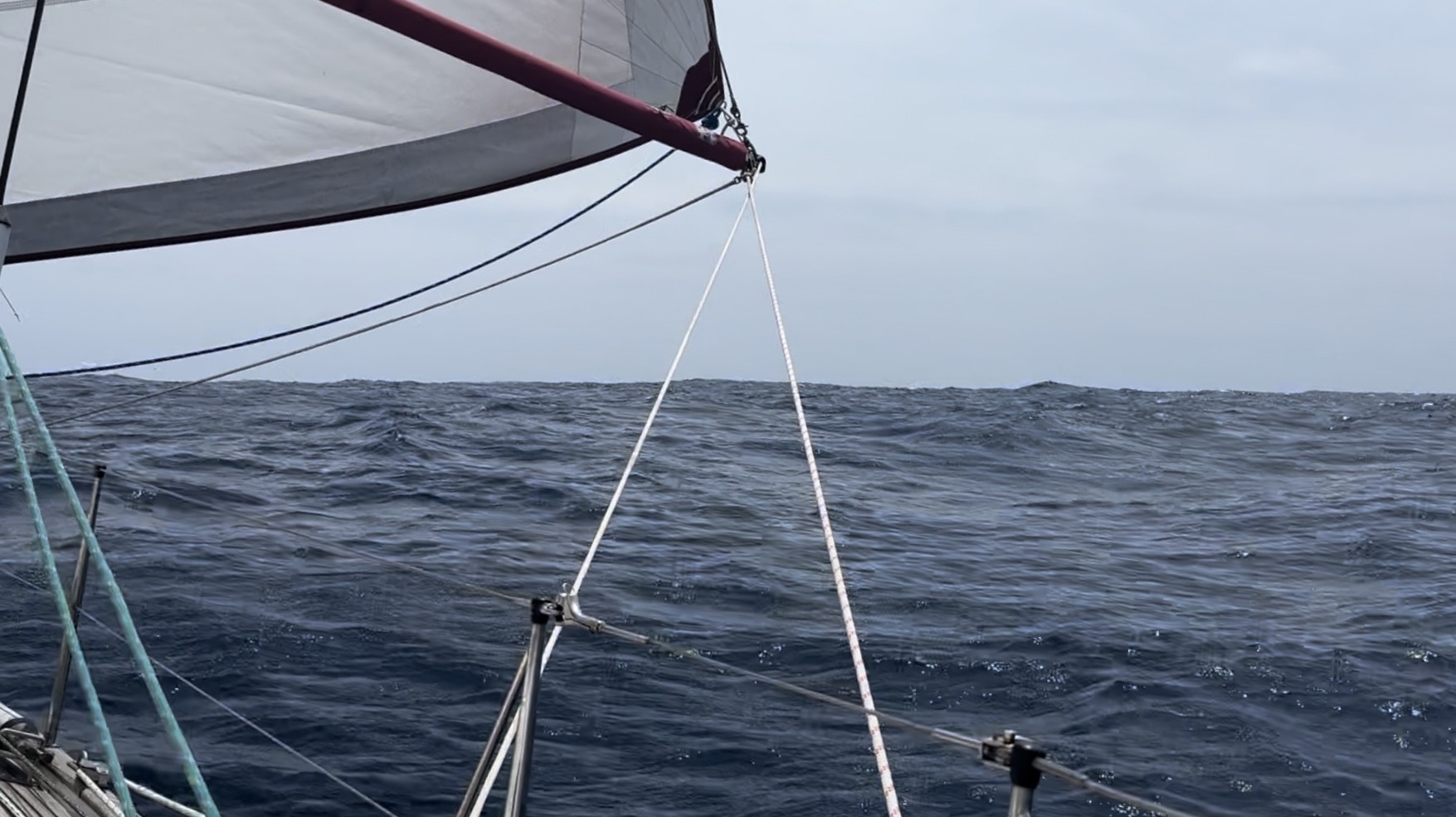
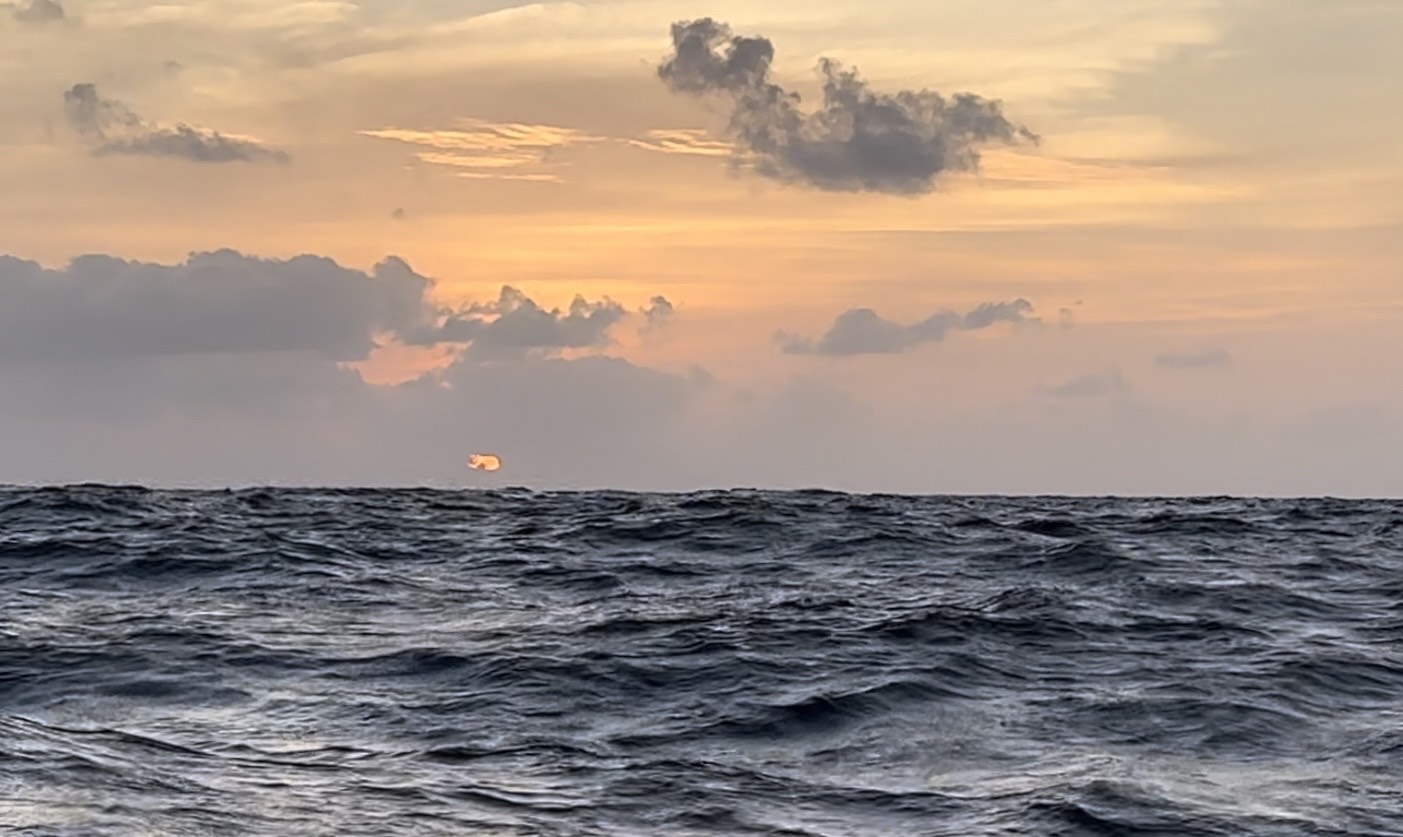
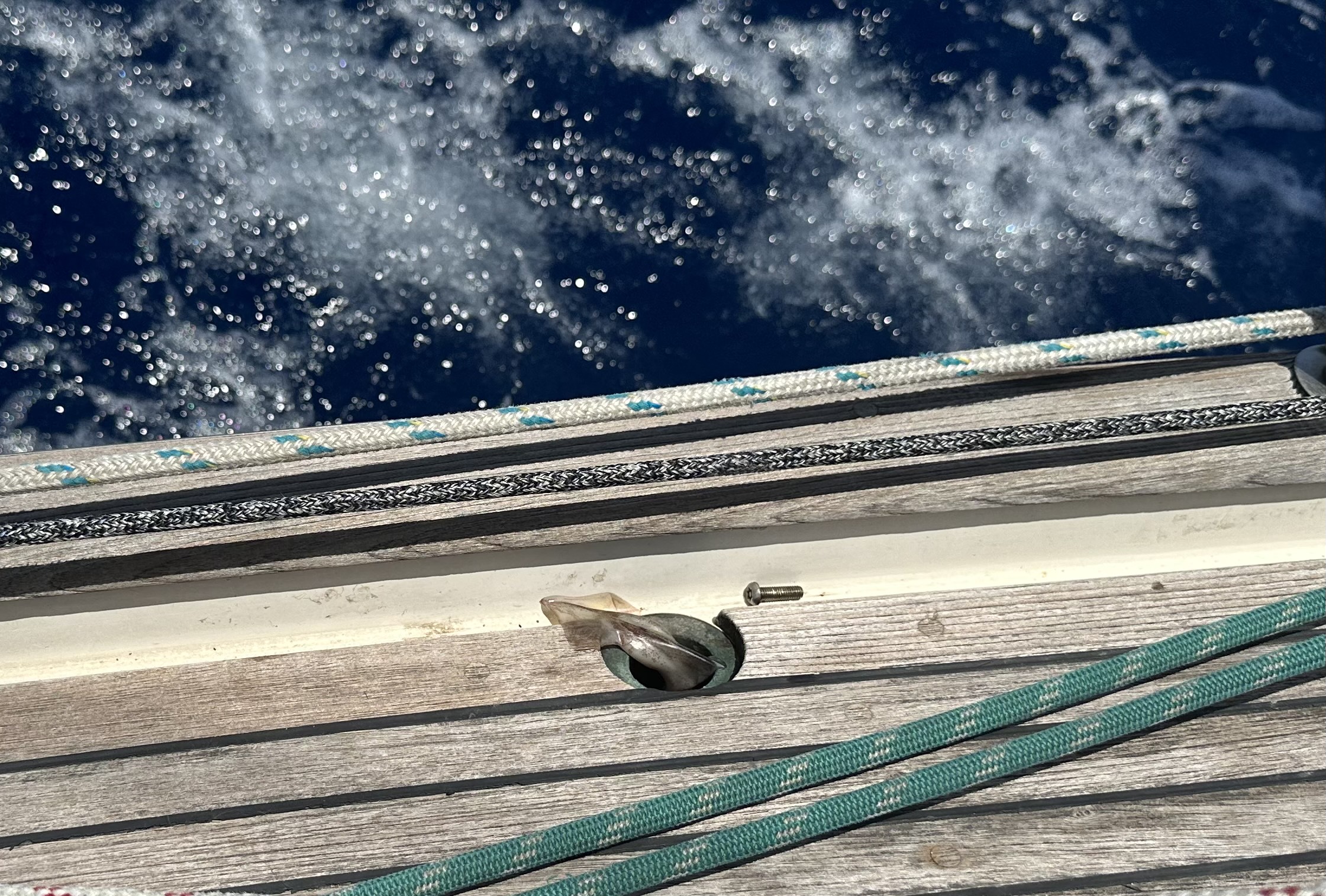
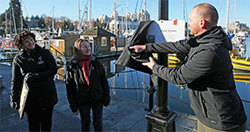 I was honoured when a busy dock in
I was honoured when a busy dock in 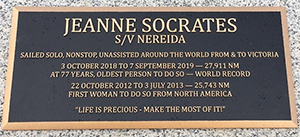 An enduring honour was the later installation of a bronze plaque, commemorating my two nonstop, single-handed, unassisted, world record circumnavigations from Victoria Harbour, on the 'wall of history' overlooking the Causeway Dock, within sight of the newly-named dock.
An enduring honour was the later installation of a bronze plaque, commemorating my two nonstop, single-handed, unassisted, world record circumnavigations from Victoria Harbour, on the 'wall of history' overlooking the Causeway Dock, within sight of the newly-named dock.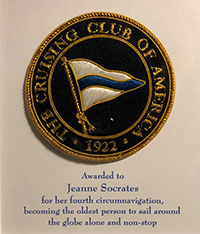 By December, I was in the warmth of Mexico, where I met up with cruising friends in La Cruz de Huanacaxtle, after flying in from Canada for a few weeks. A short trip to San Francisco followed shortly after, and I received a CCA Special Recognition Award at an enjoyable Dinner held at the St Francis Y.C. and later met other Bay friends in Belvedere at the San Francisco Y.C., as well as being interviewed by a local radio station.
By December, I was in the warmth of Mexico, where I met up with cruising friends in La Cruz de Huanacaxtle, after flying in from Canada for a few weeks. A short trip to San Francisco followed shortly after, and I received a CCA Special Recognition Award at an enjoyable Dinner held at the St Francis Y.C. and later met other Bay friends in Belvedere at the San Francisco Y.C., as well as being interviewed by a local radio station.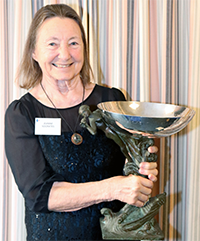 Later in January, I flew to London, following an invitation from the Cruising Association who awarded me with their Duchess of Kent Trophy as a result of my 2018-19 circumnavigation. I had a good chat during the Flag Officers' Lunch with Sir Robin Knox-Johnson who presented the award to me - for the second time. Many thanks to the C.A. for honouring me and for their warm hospitality.
Later in January, I flew to London, following an invitation from the Cruising Association who awarded me with their Duchess of Kent Trophy as a result of my 2018-19 circumnavigation. I had a good chat during the Flag Officers' Lunch with Sir Robin Knox-Johnson who presented the award to me - for the second time. Many thanks to the C.A. for honouring me and for their warm hospitality.